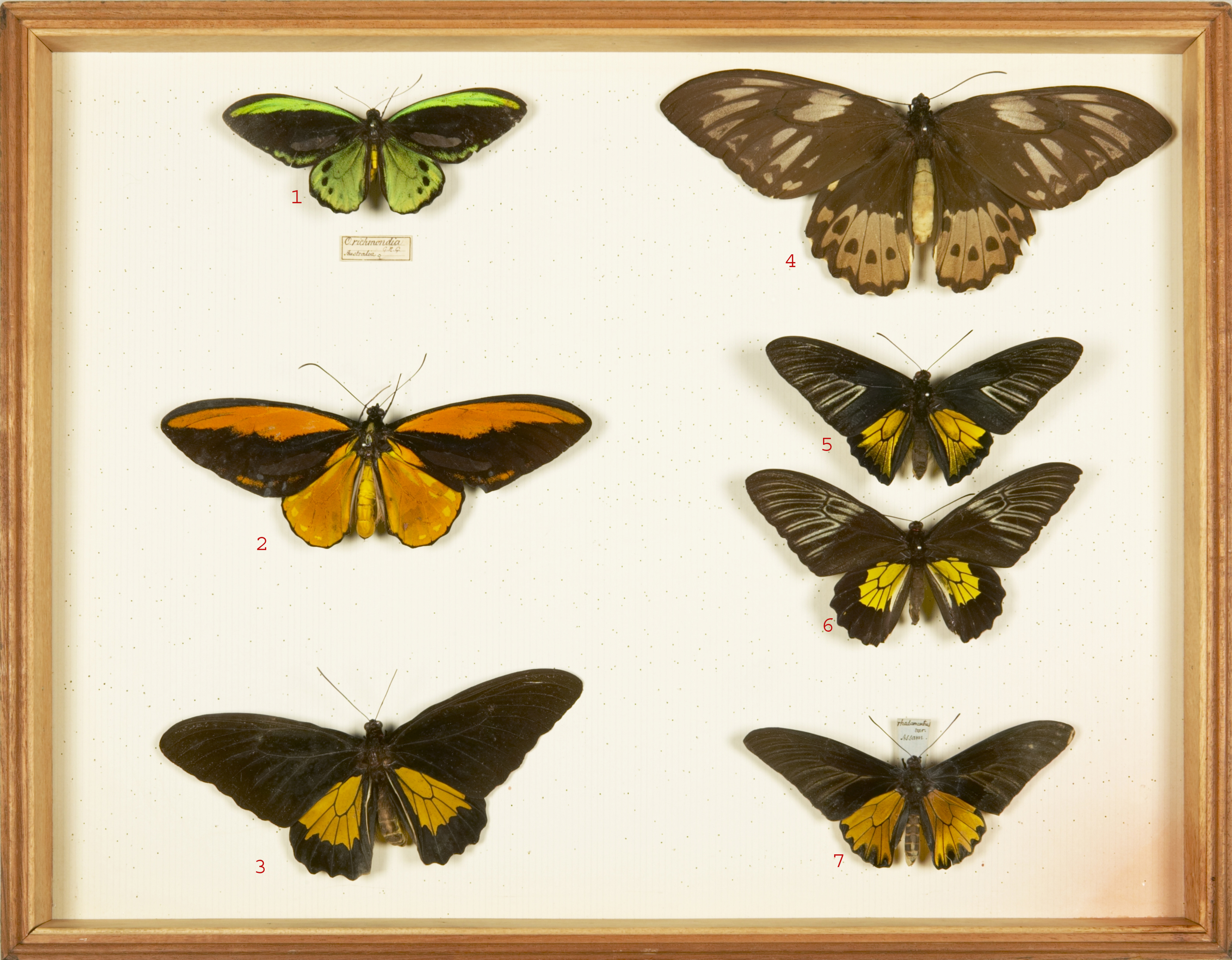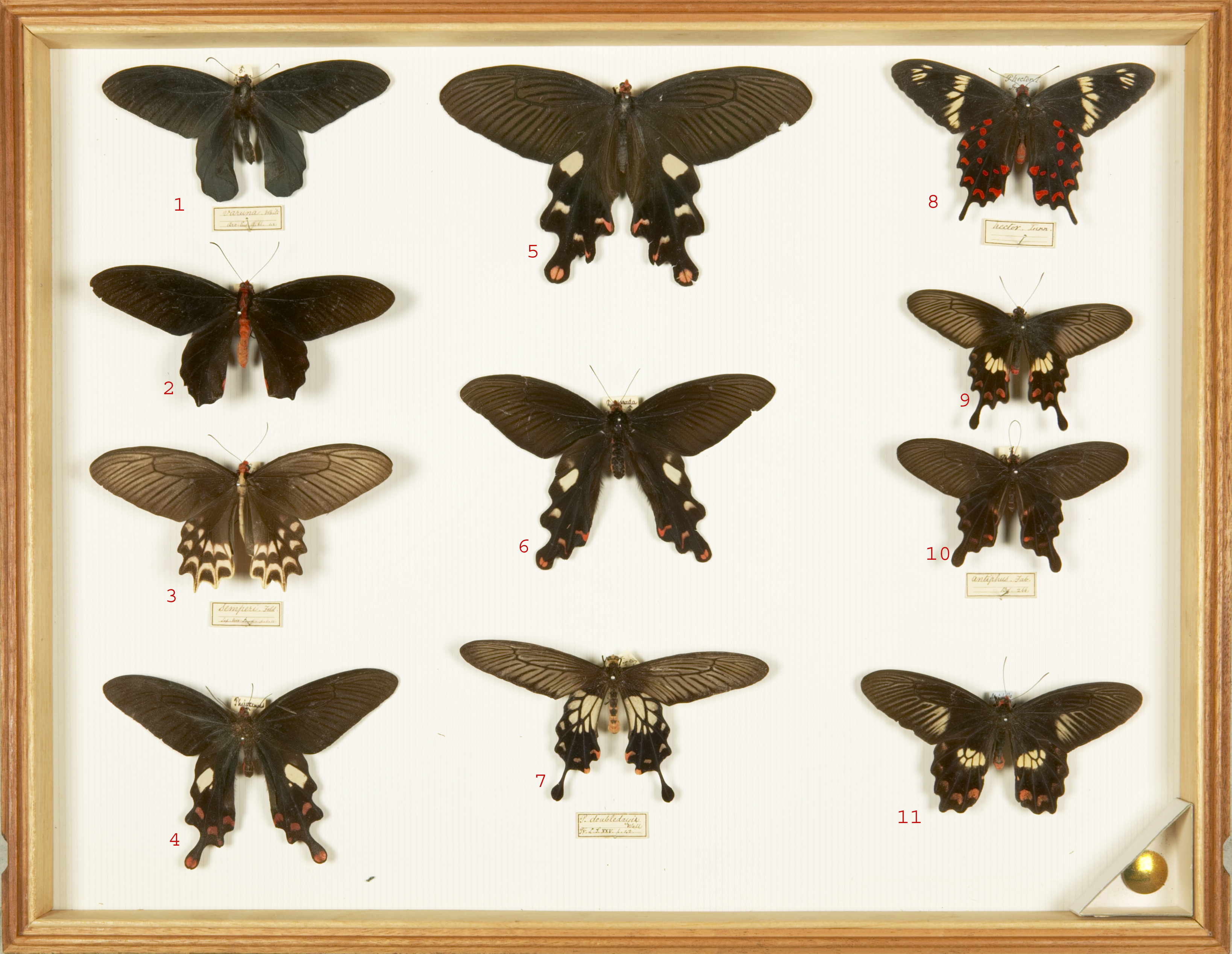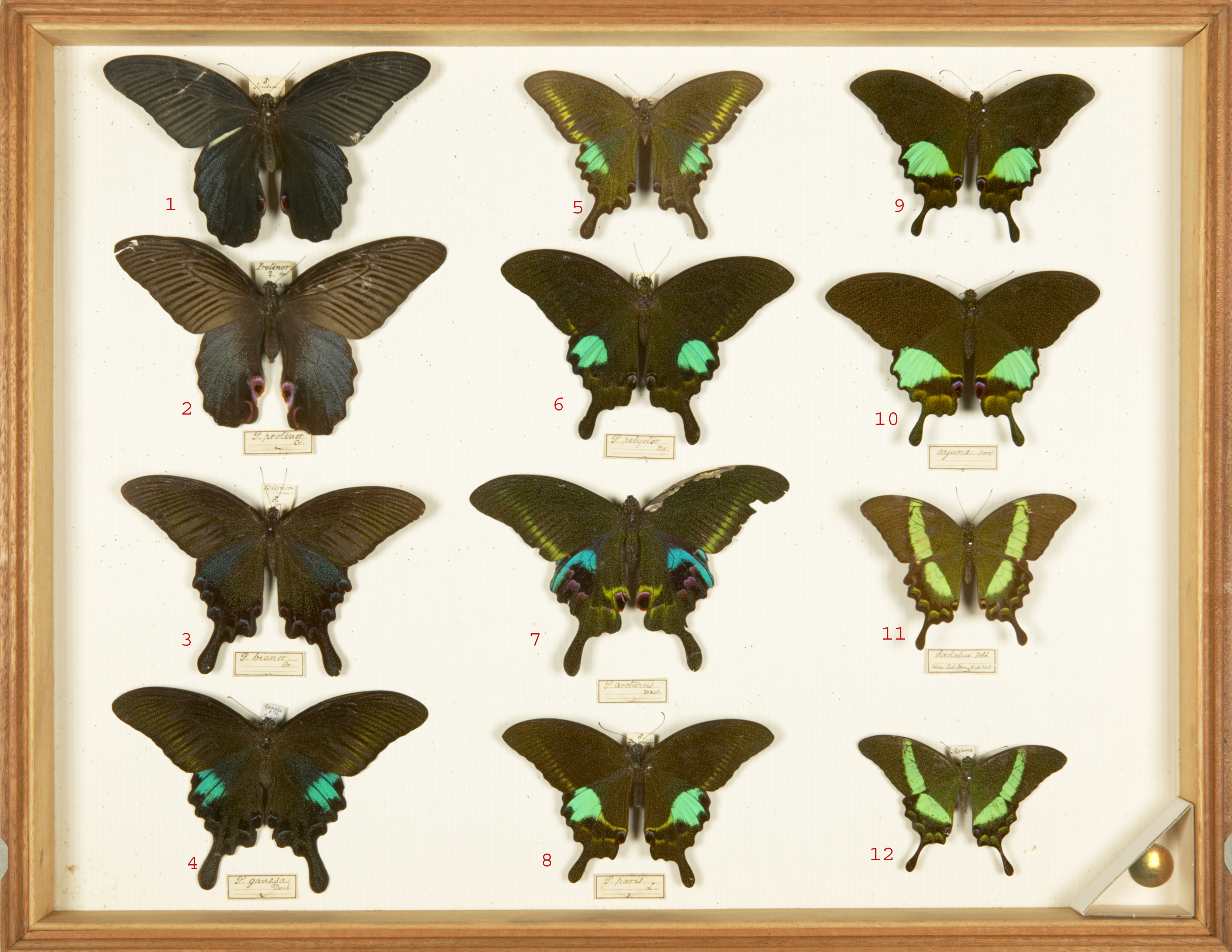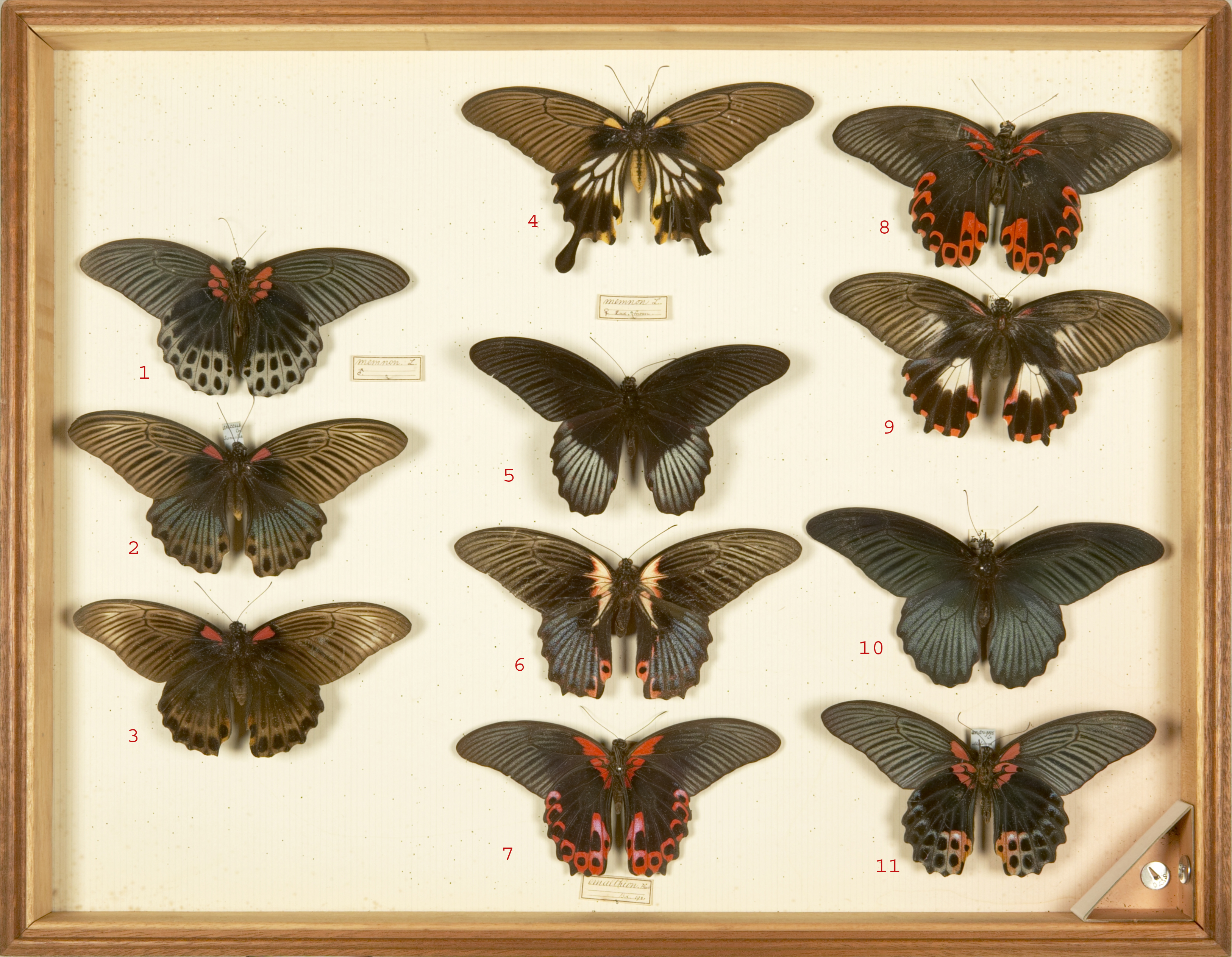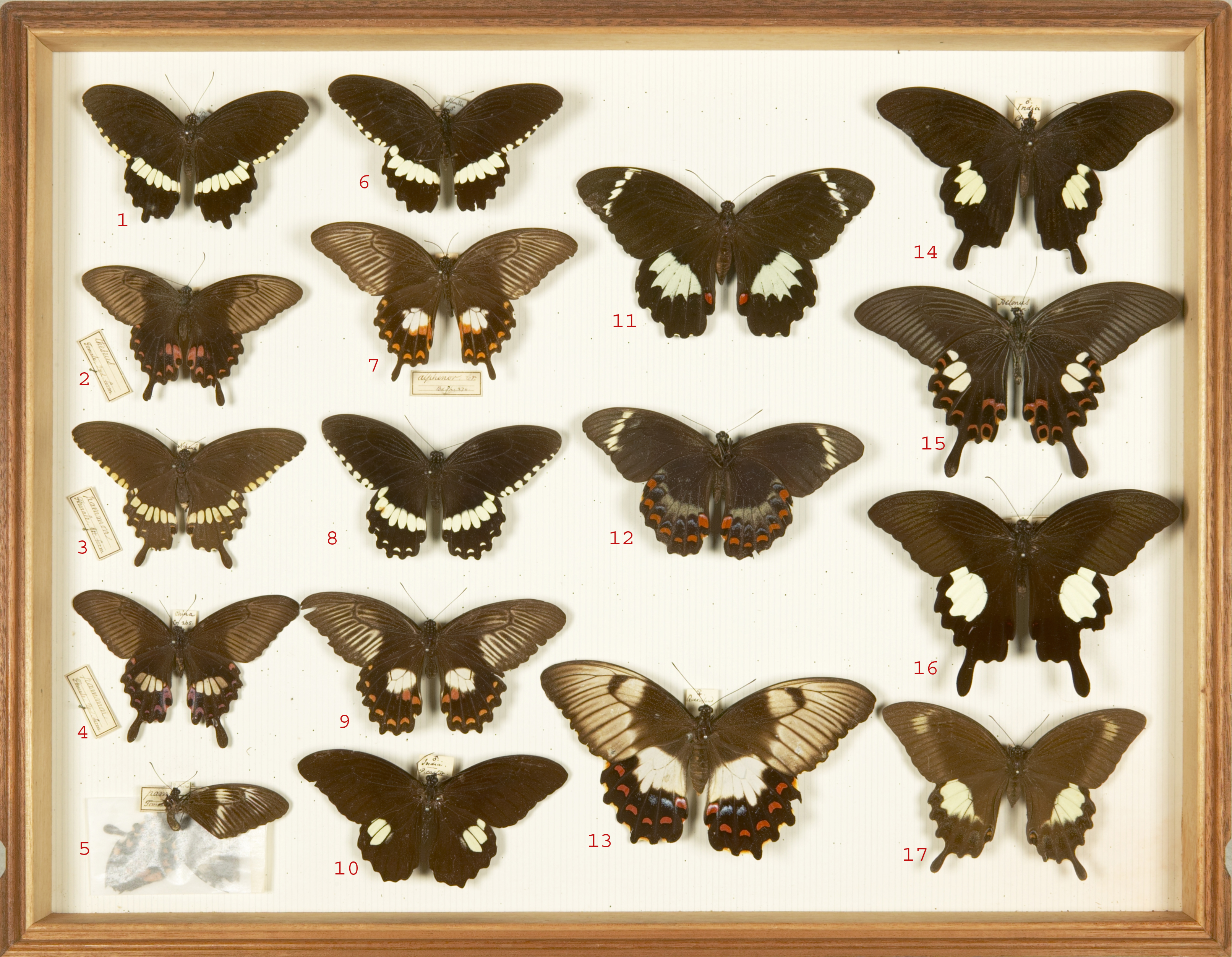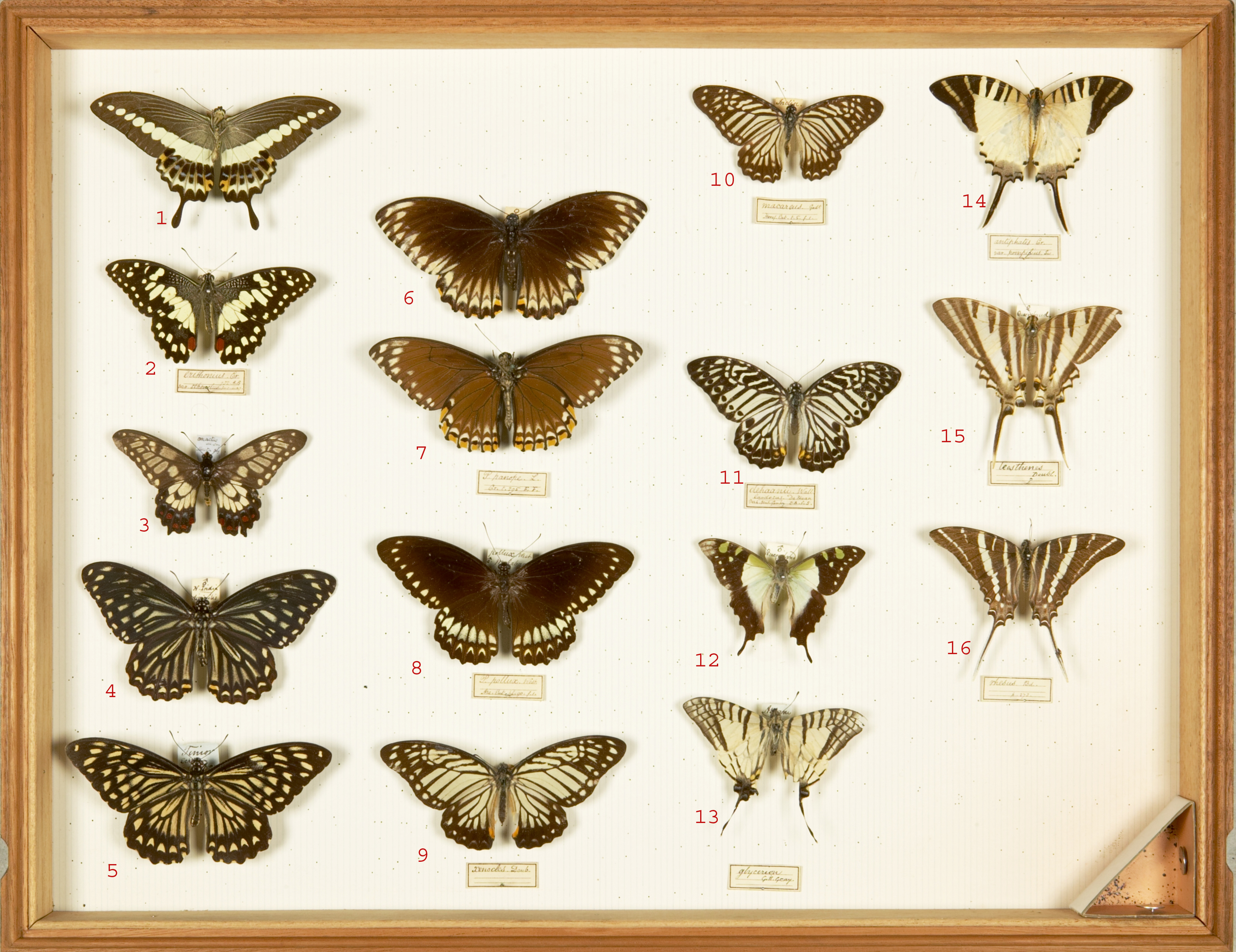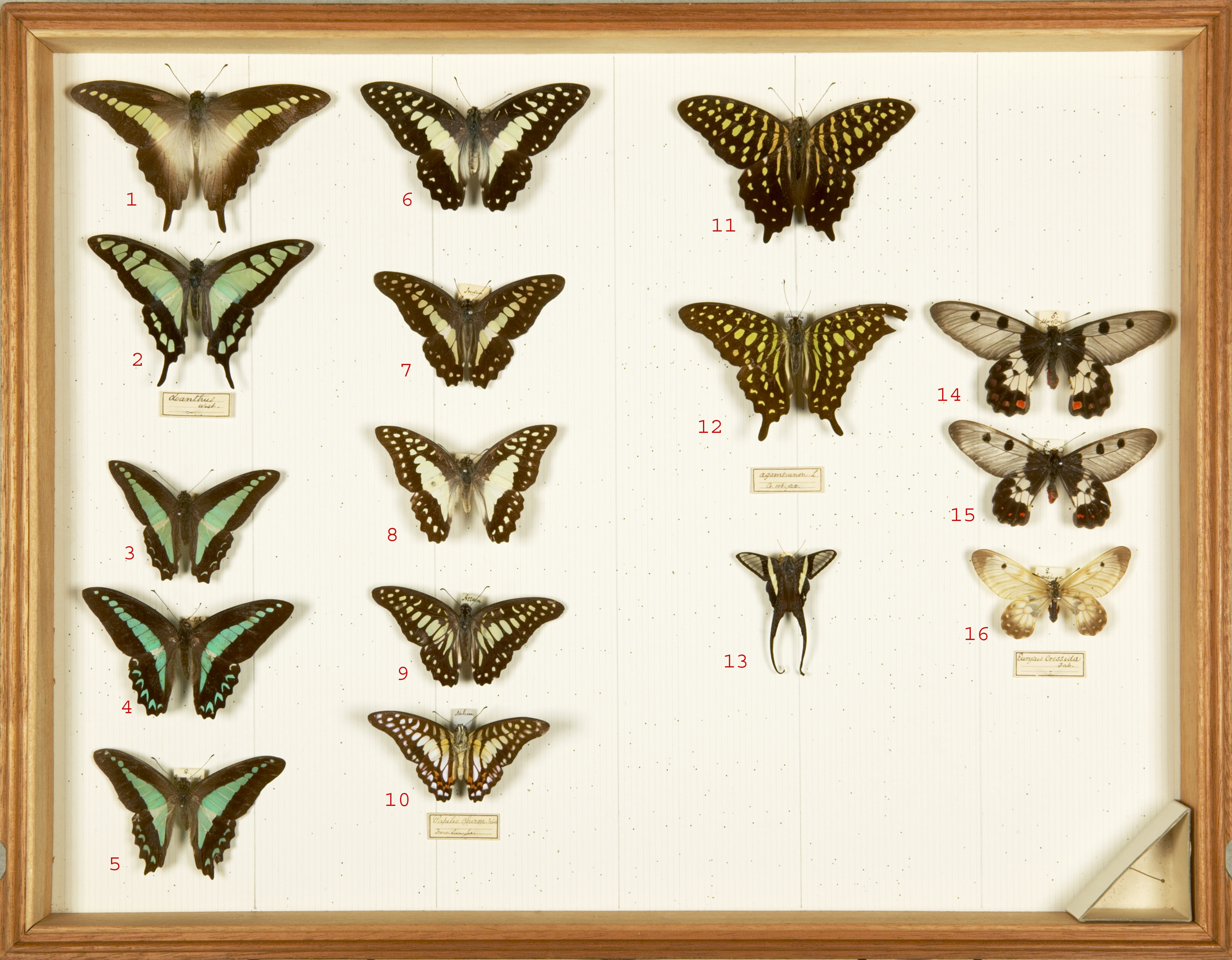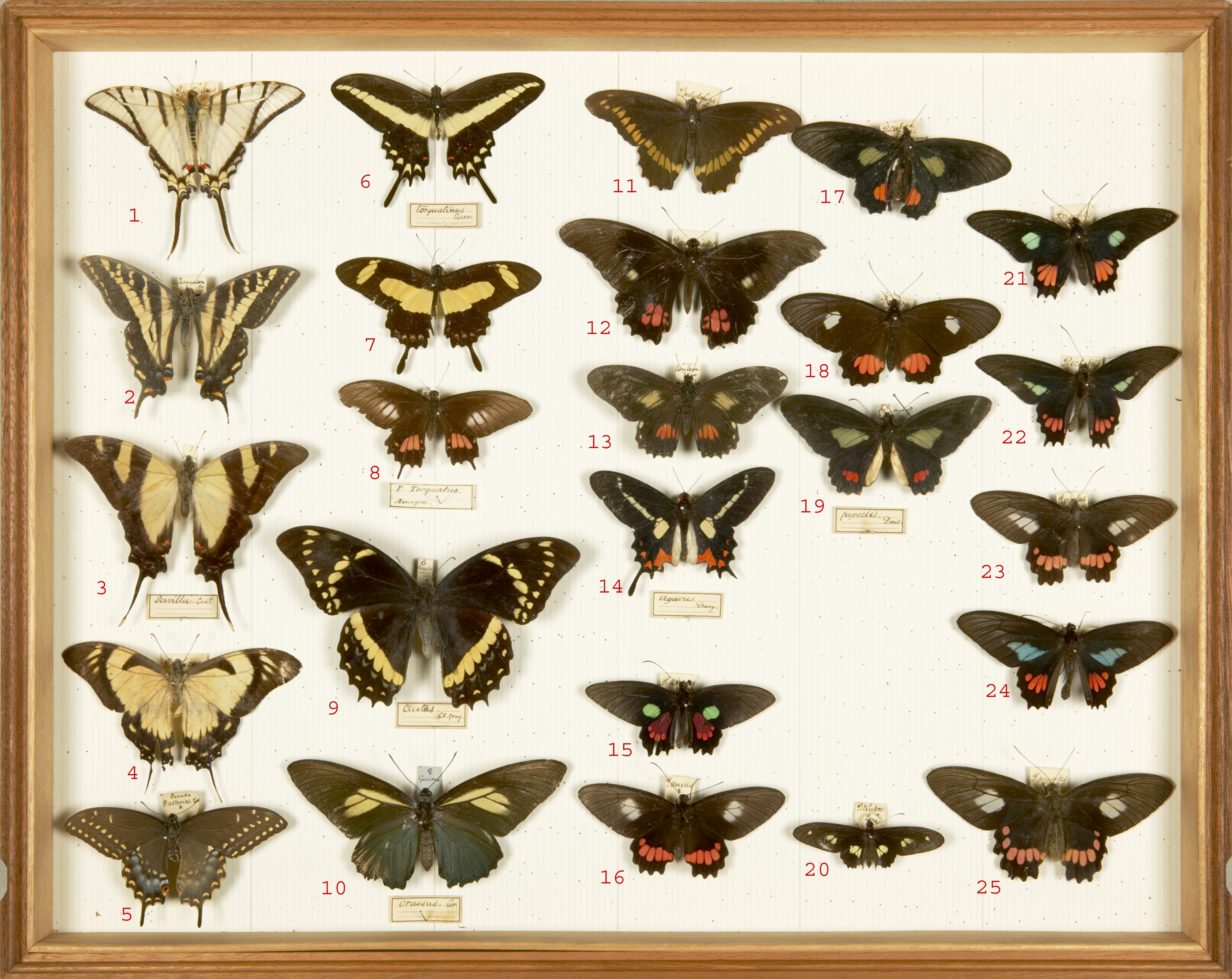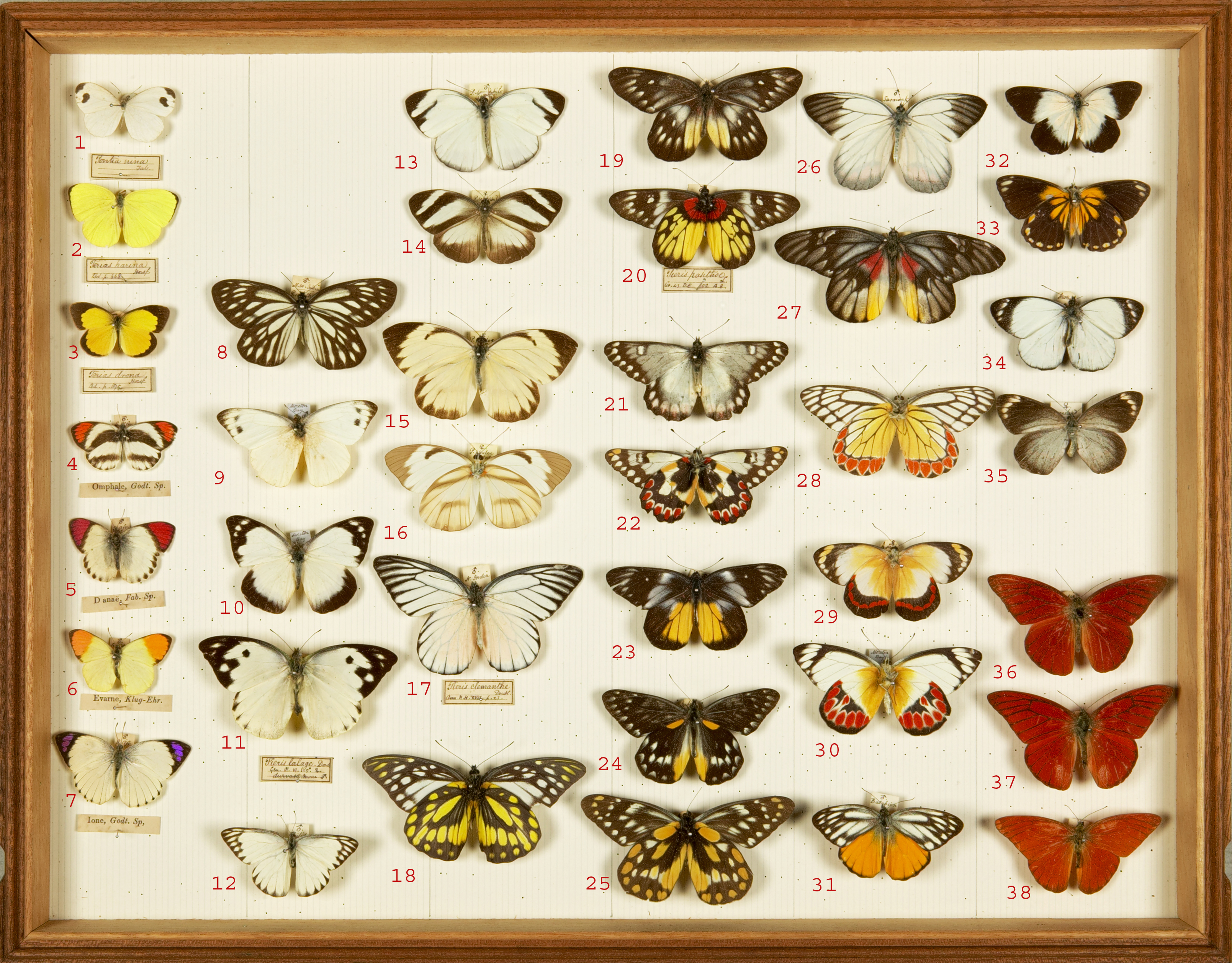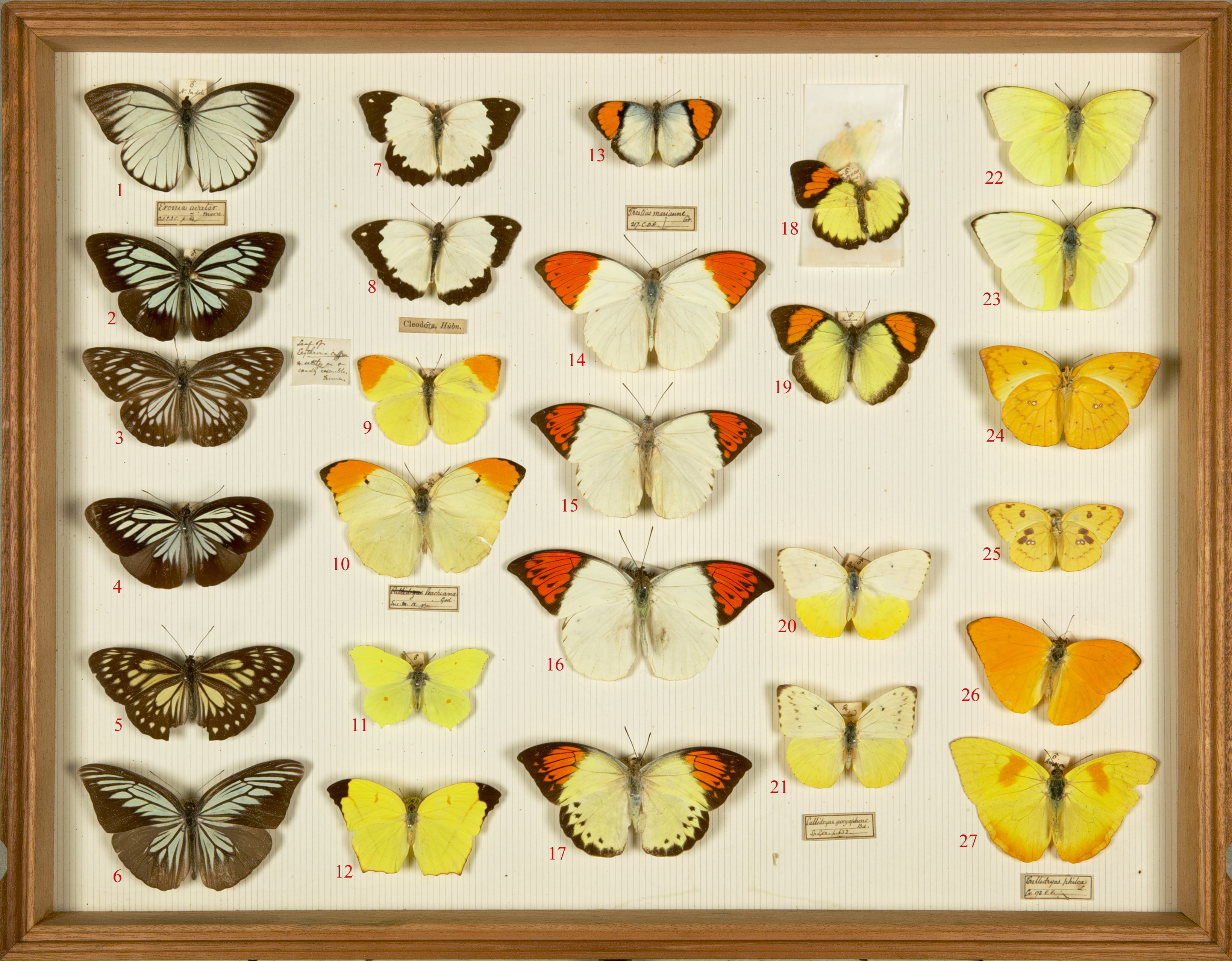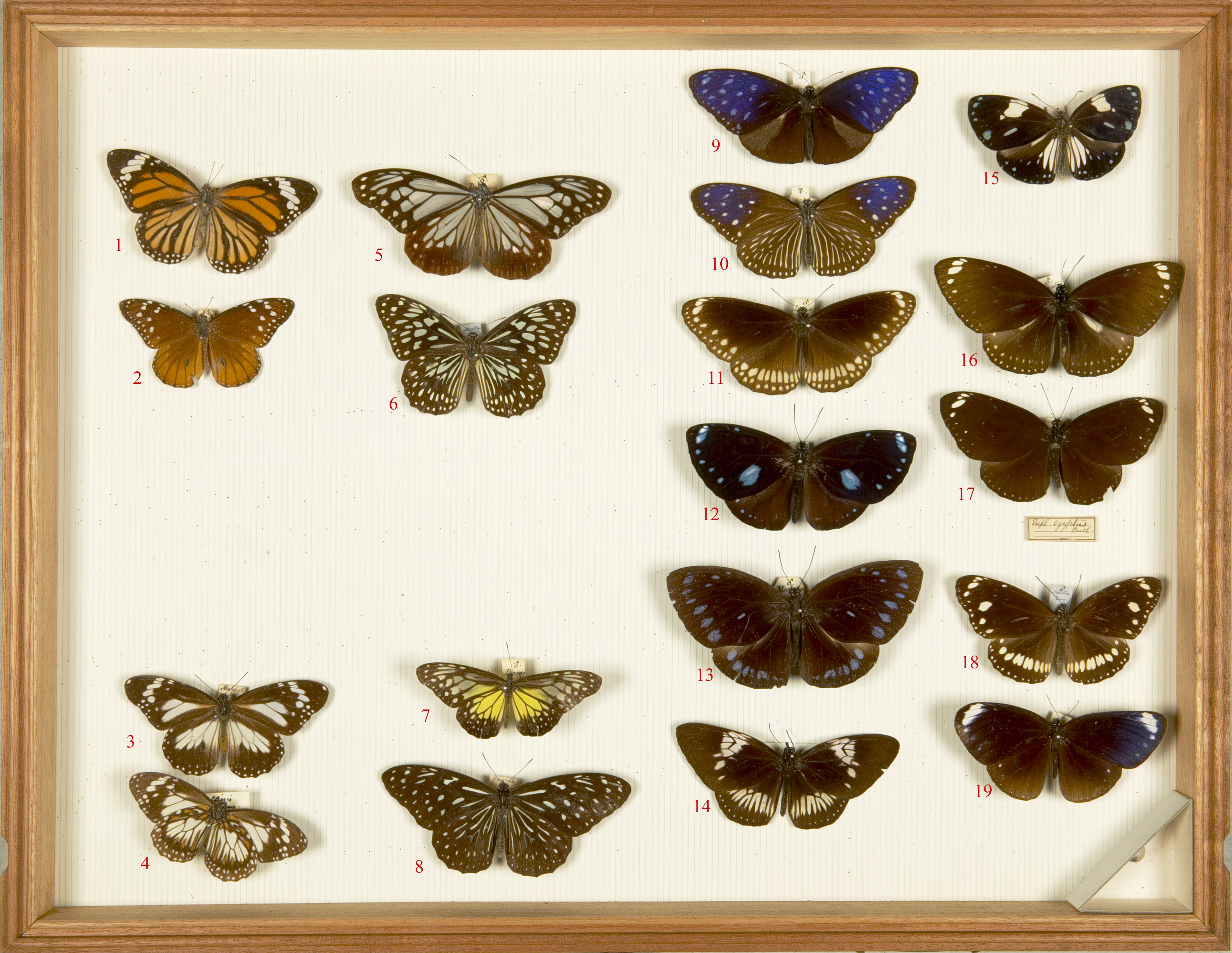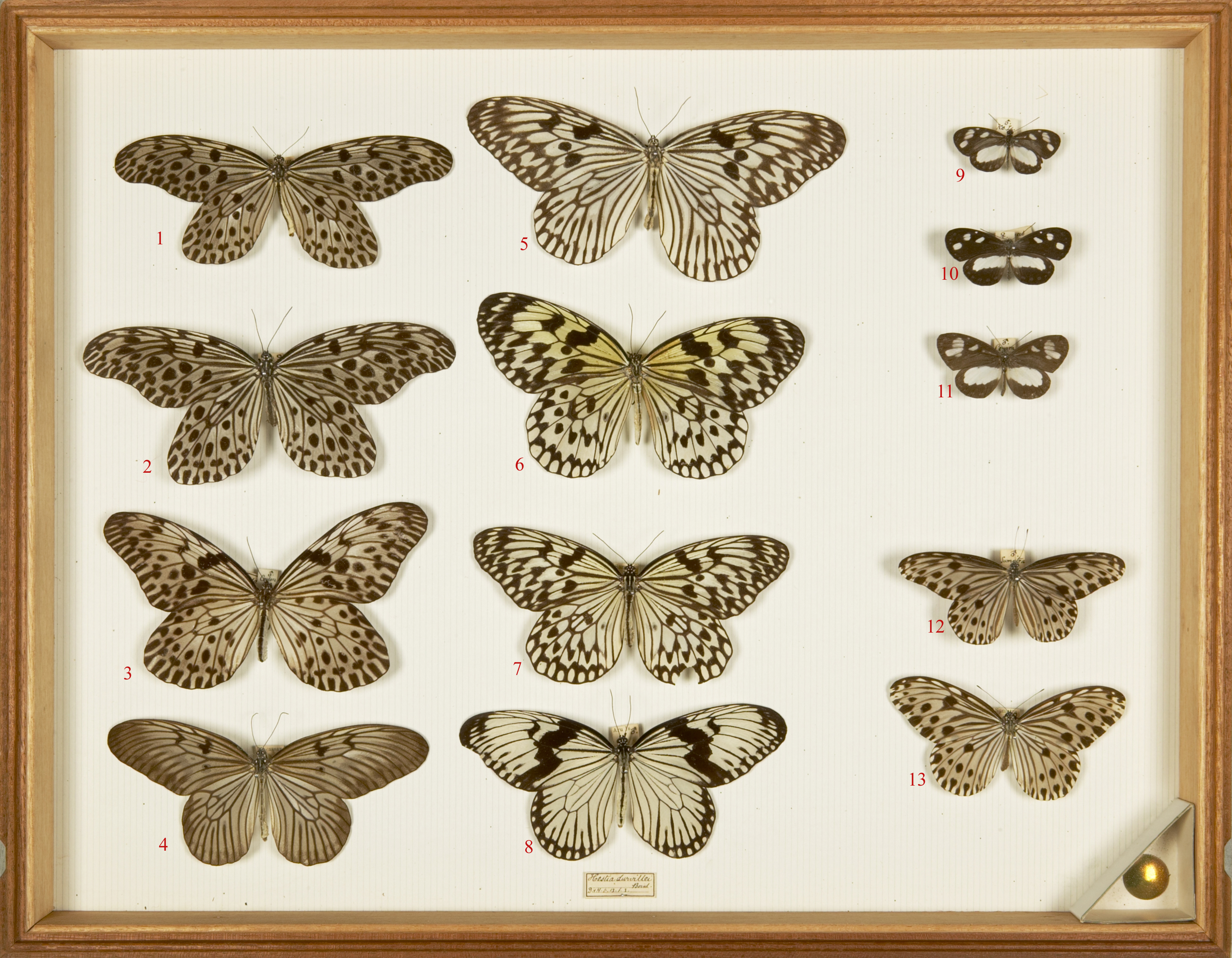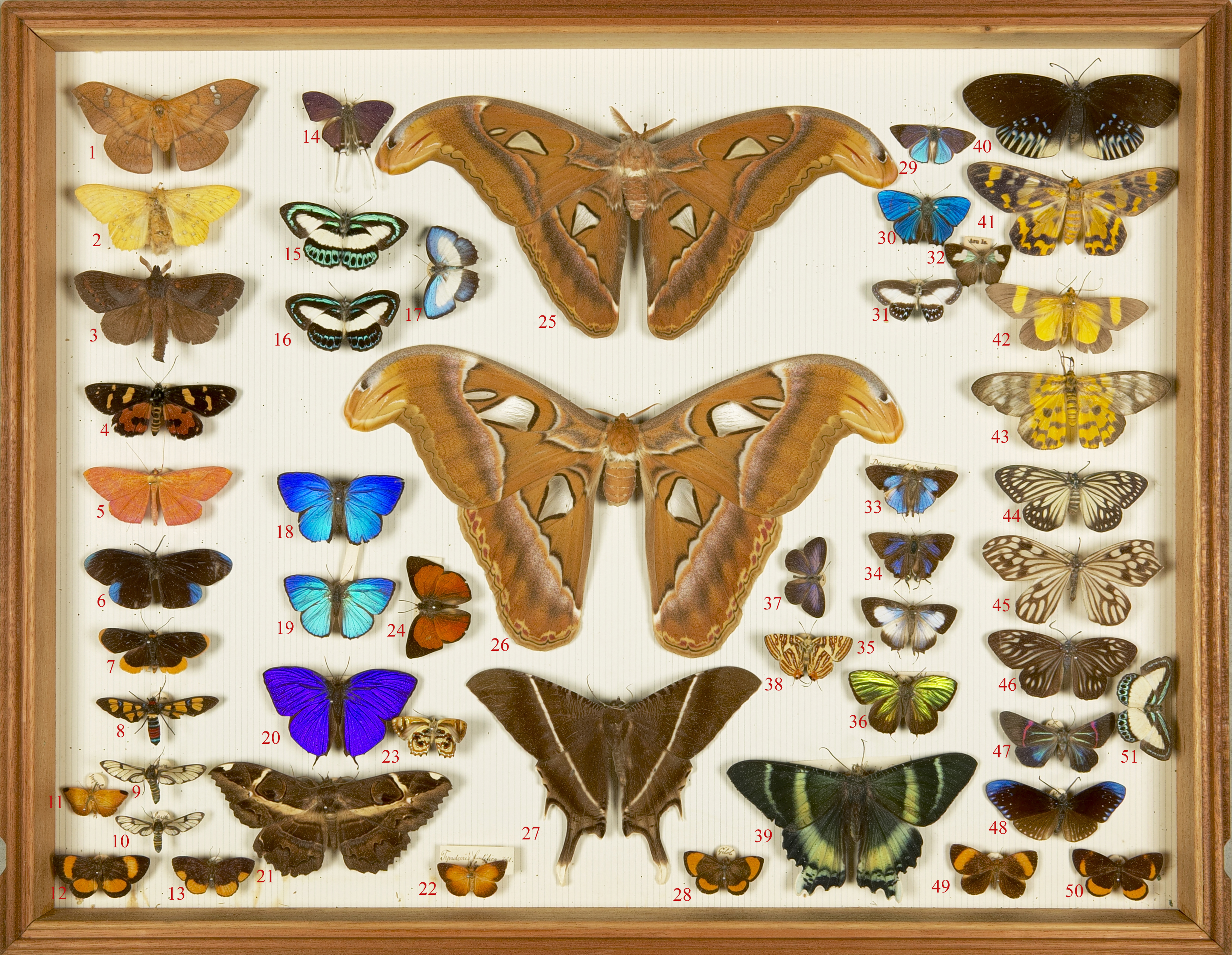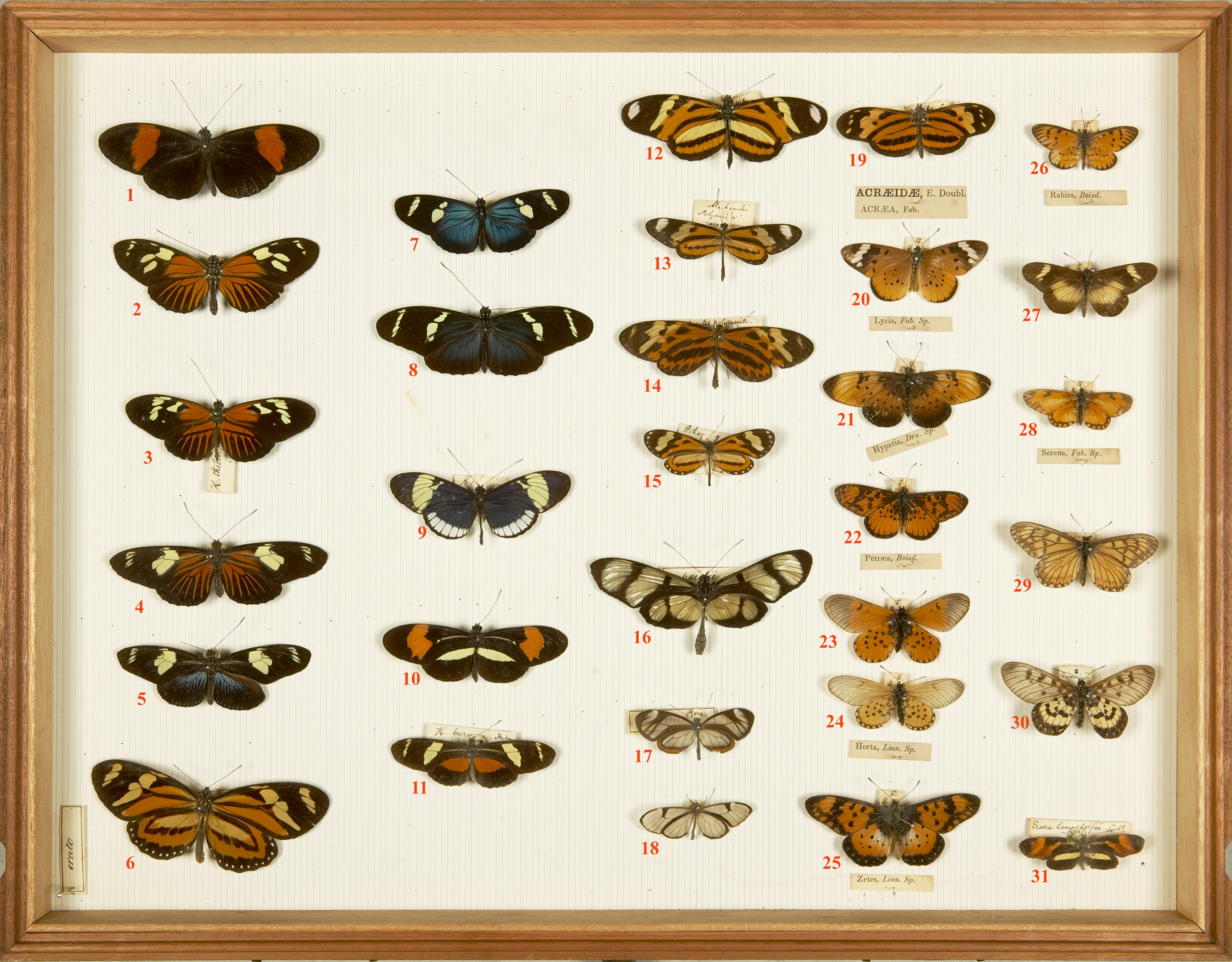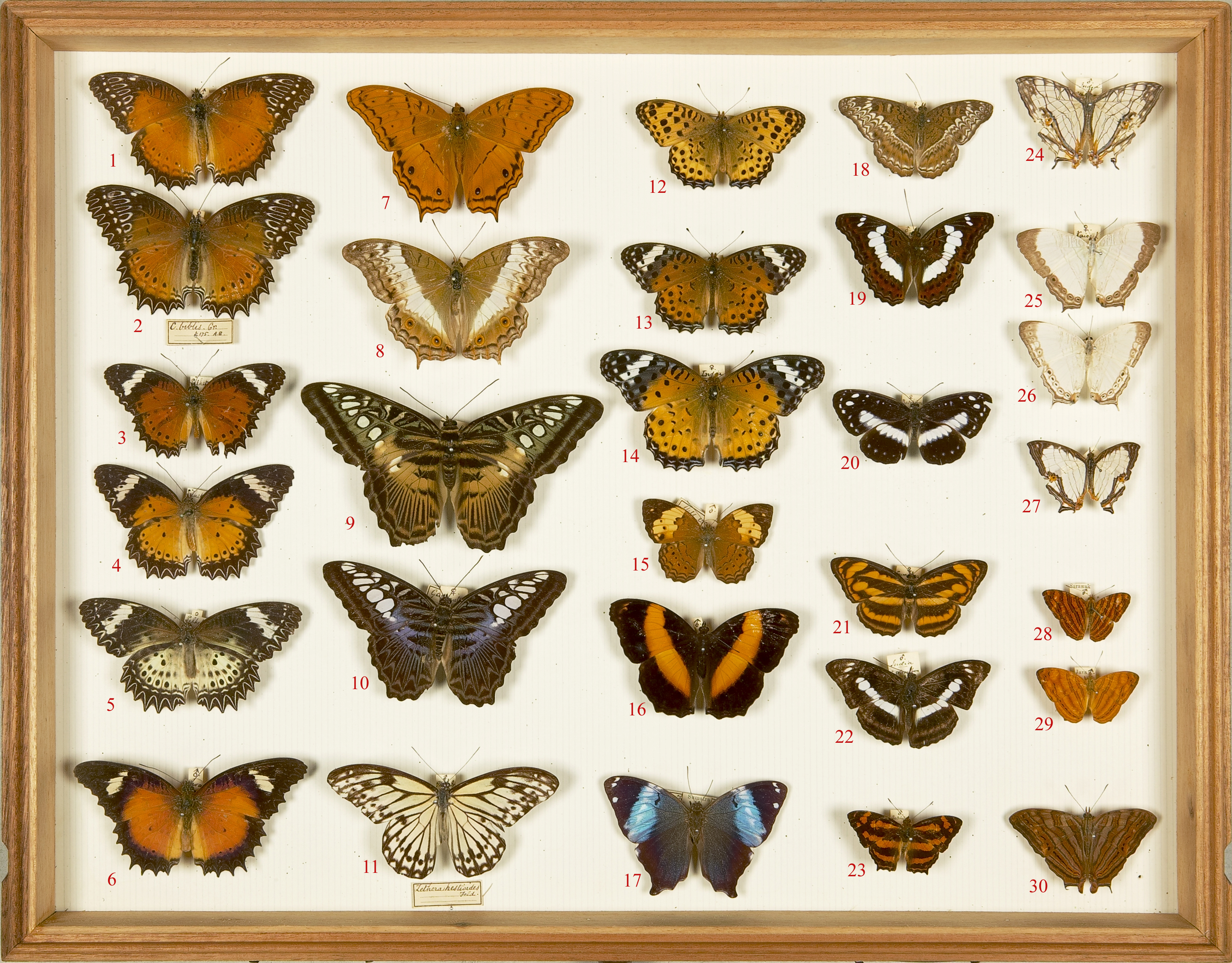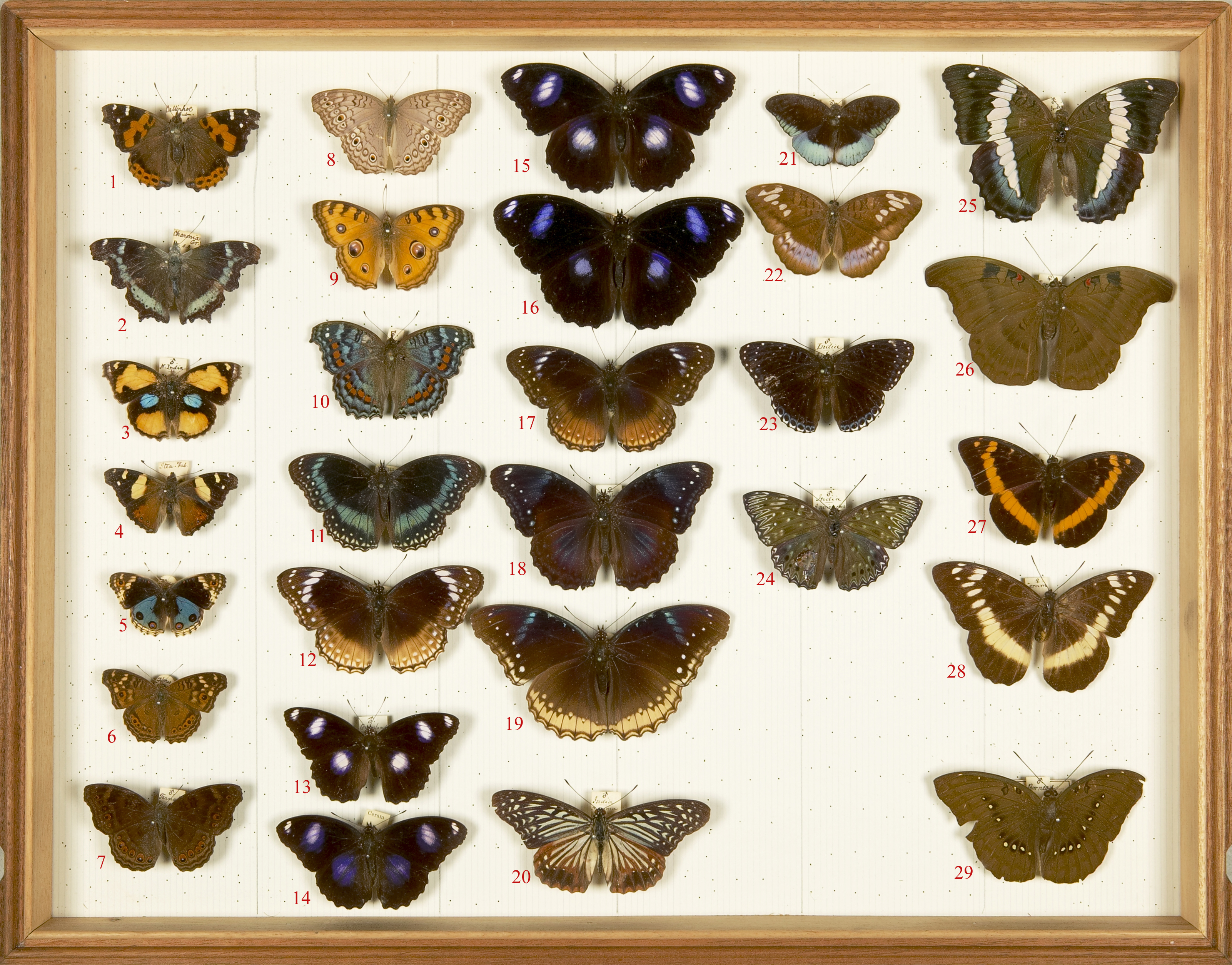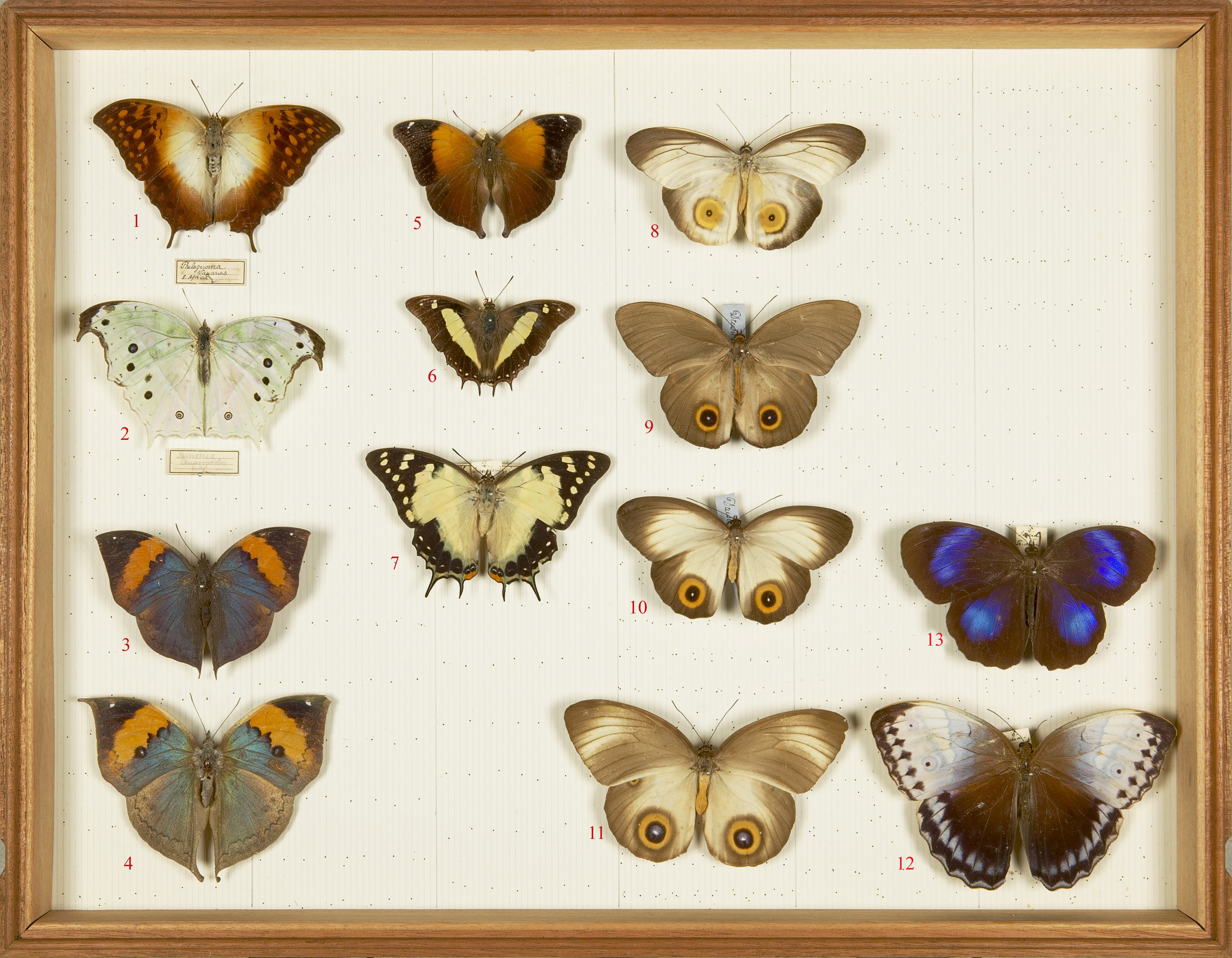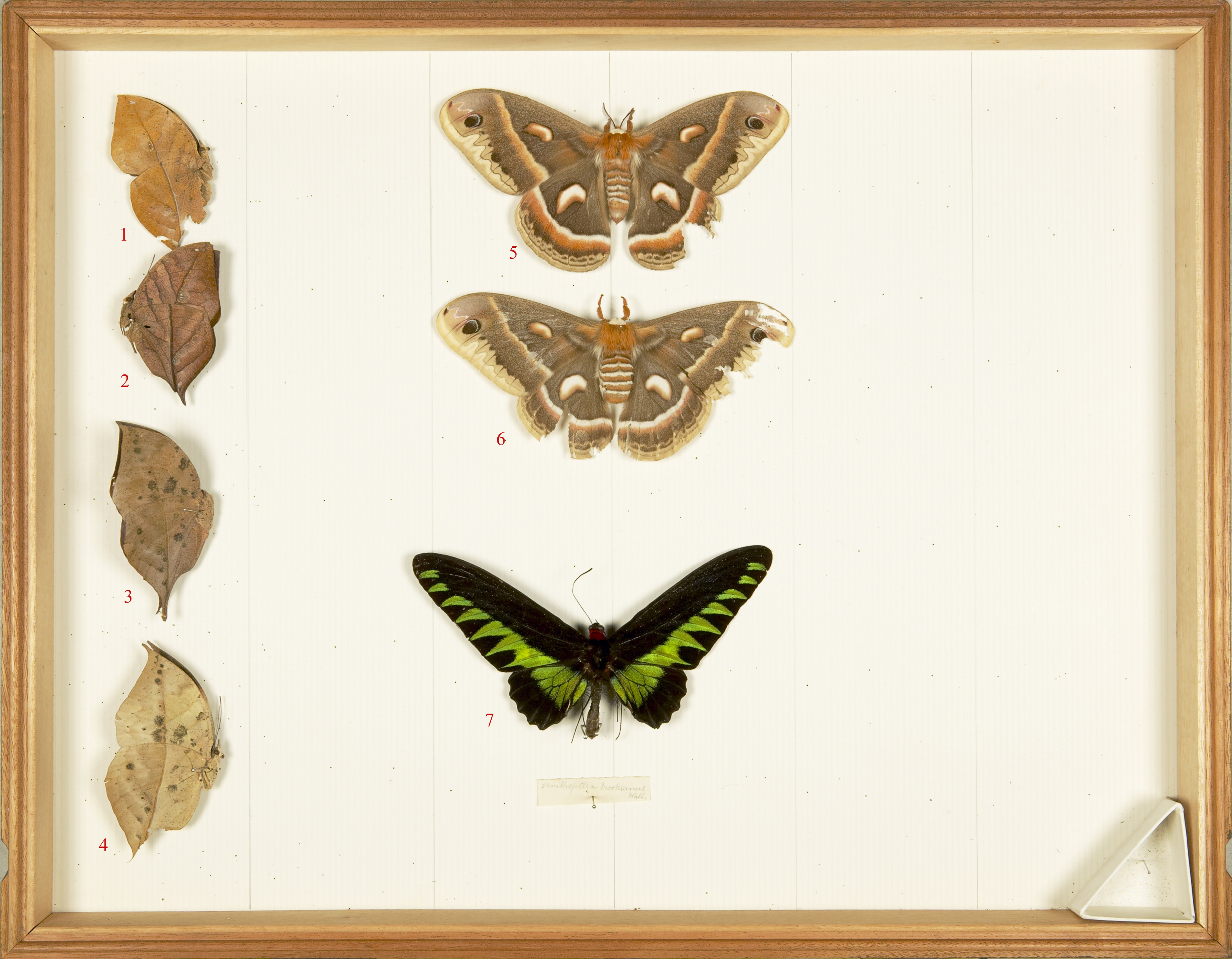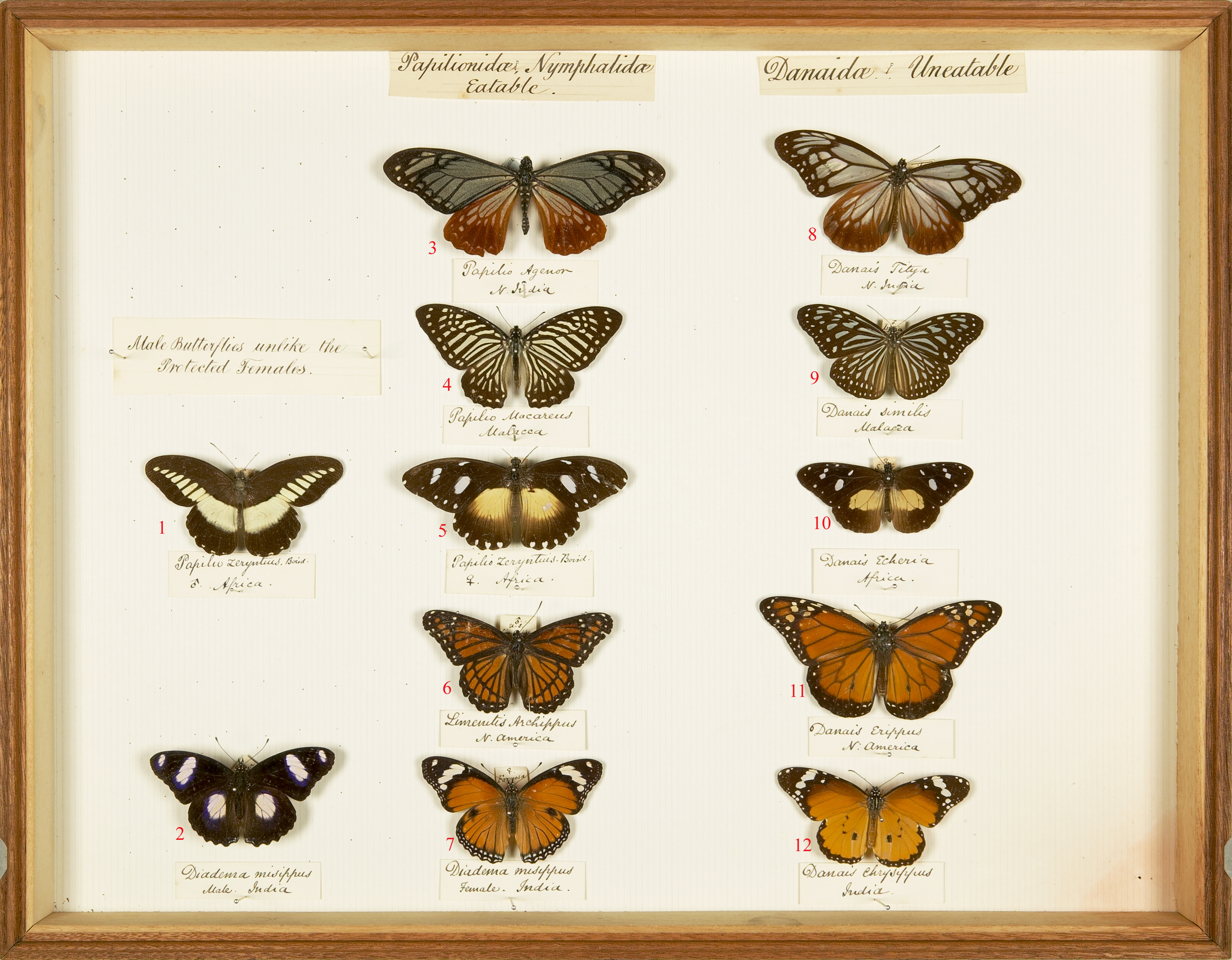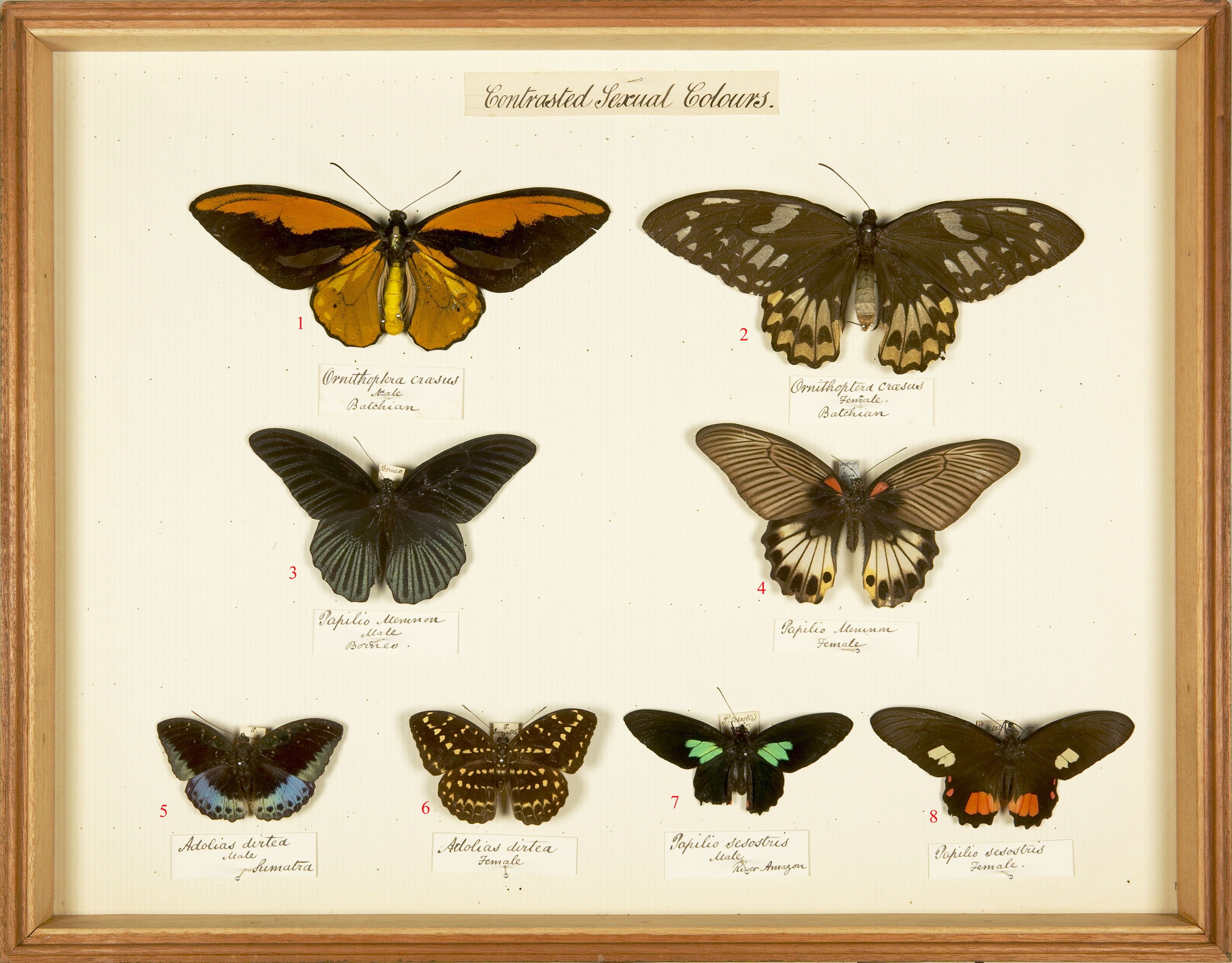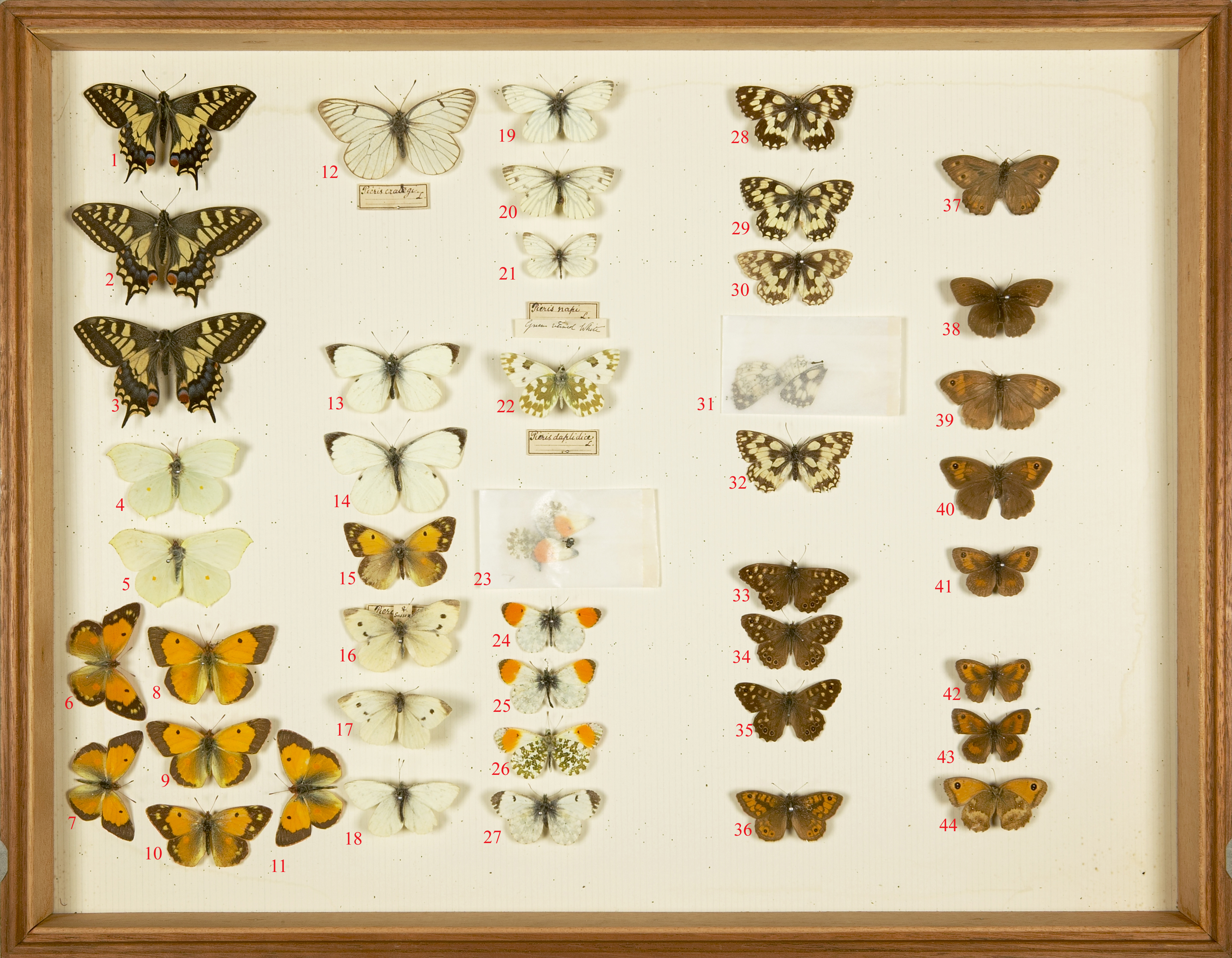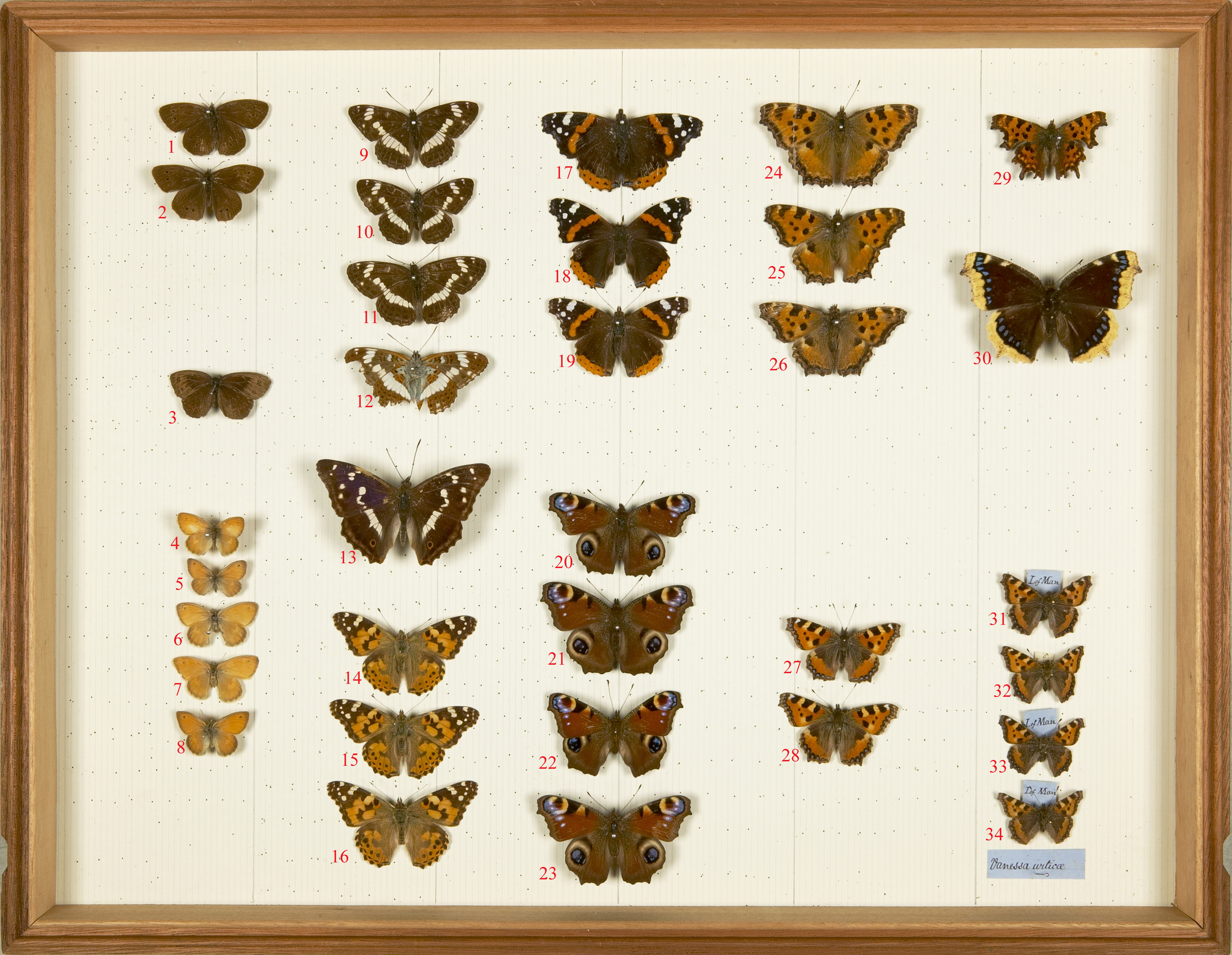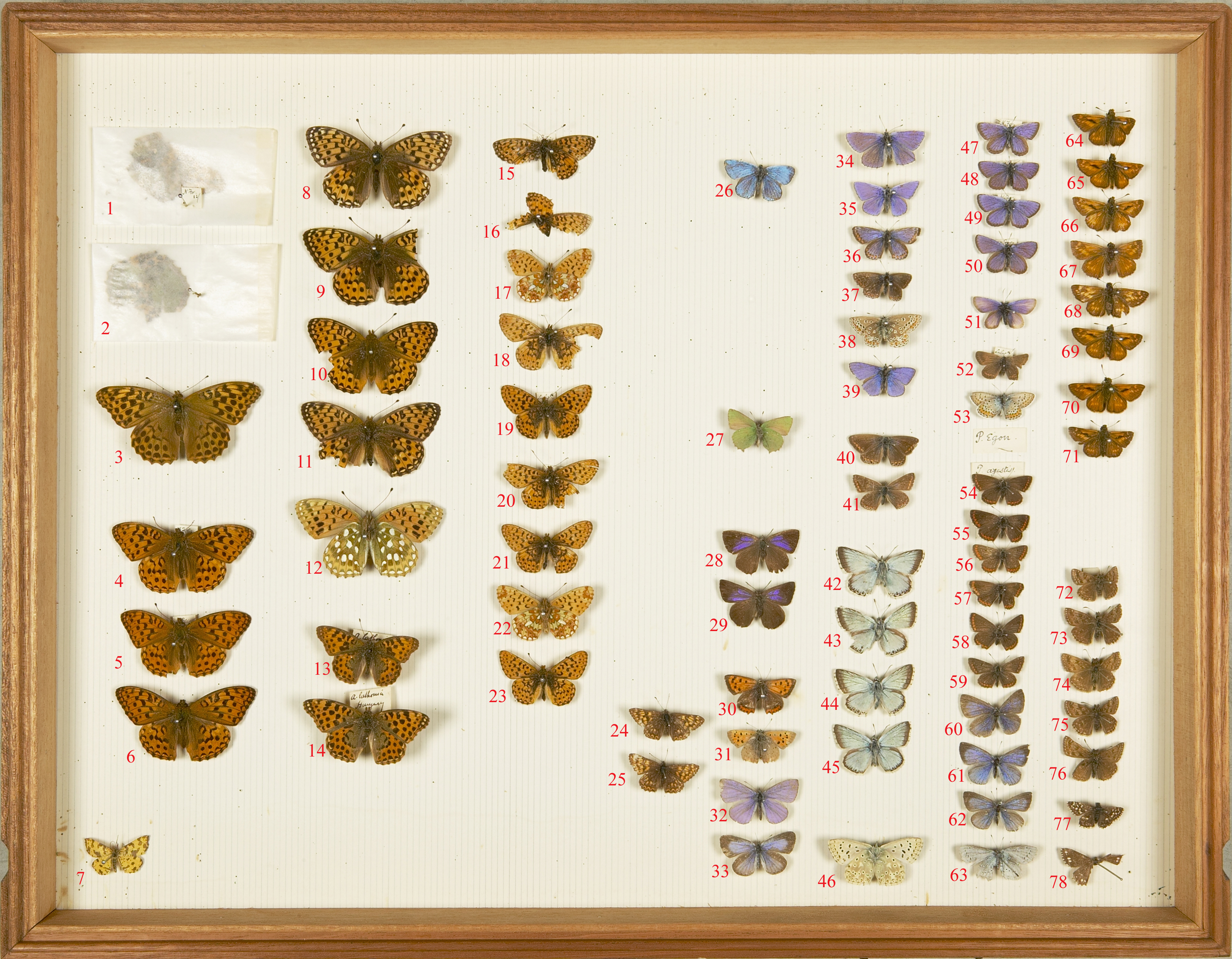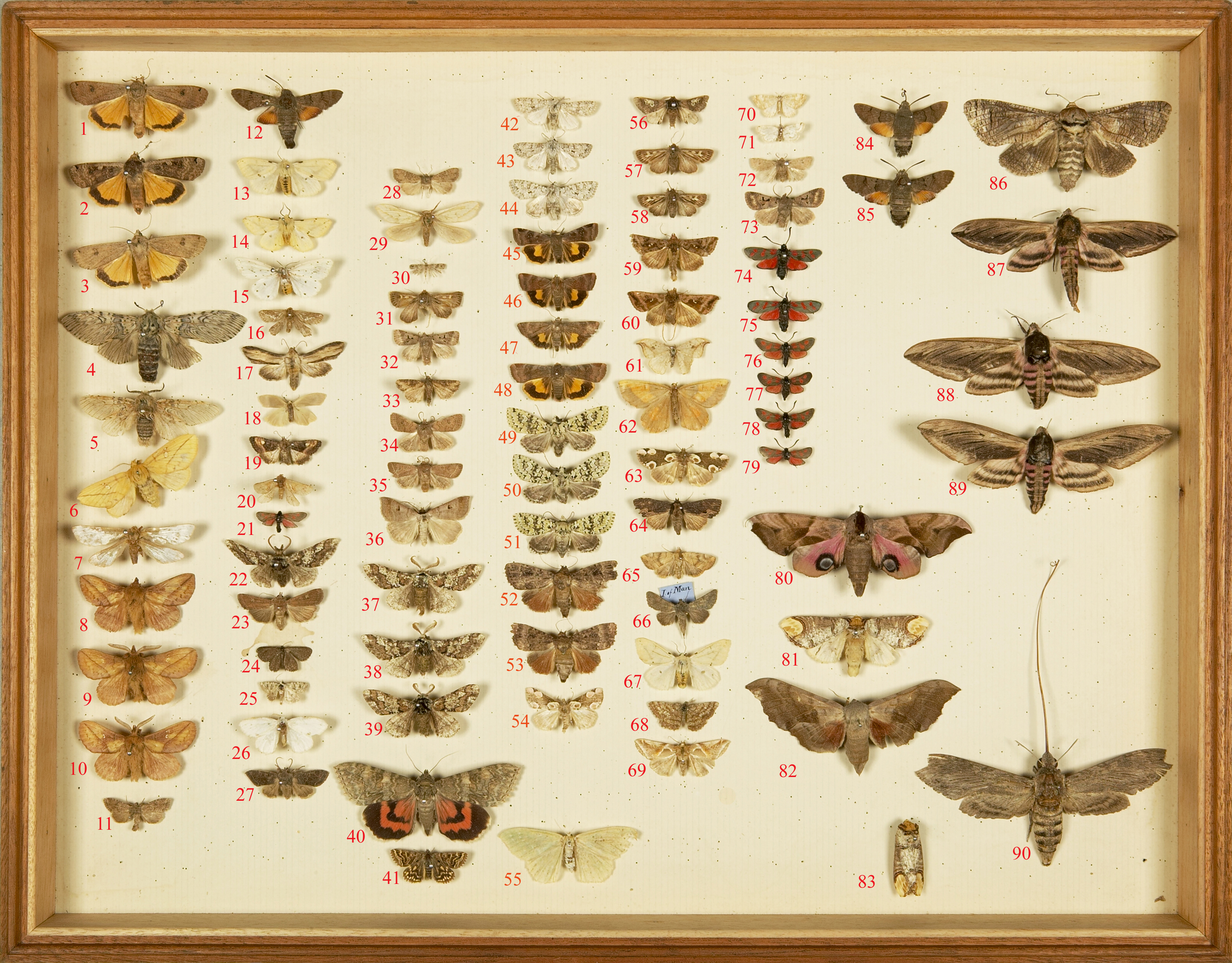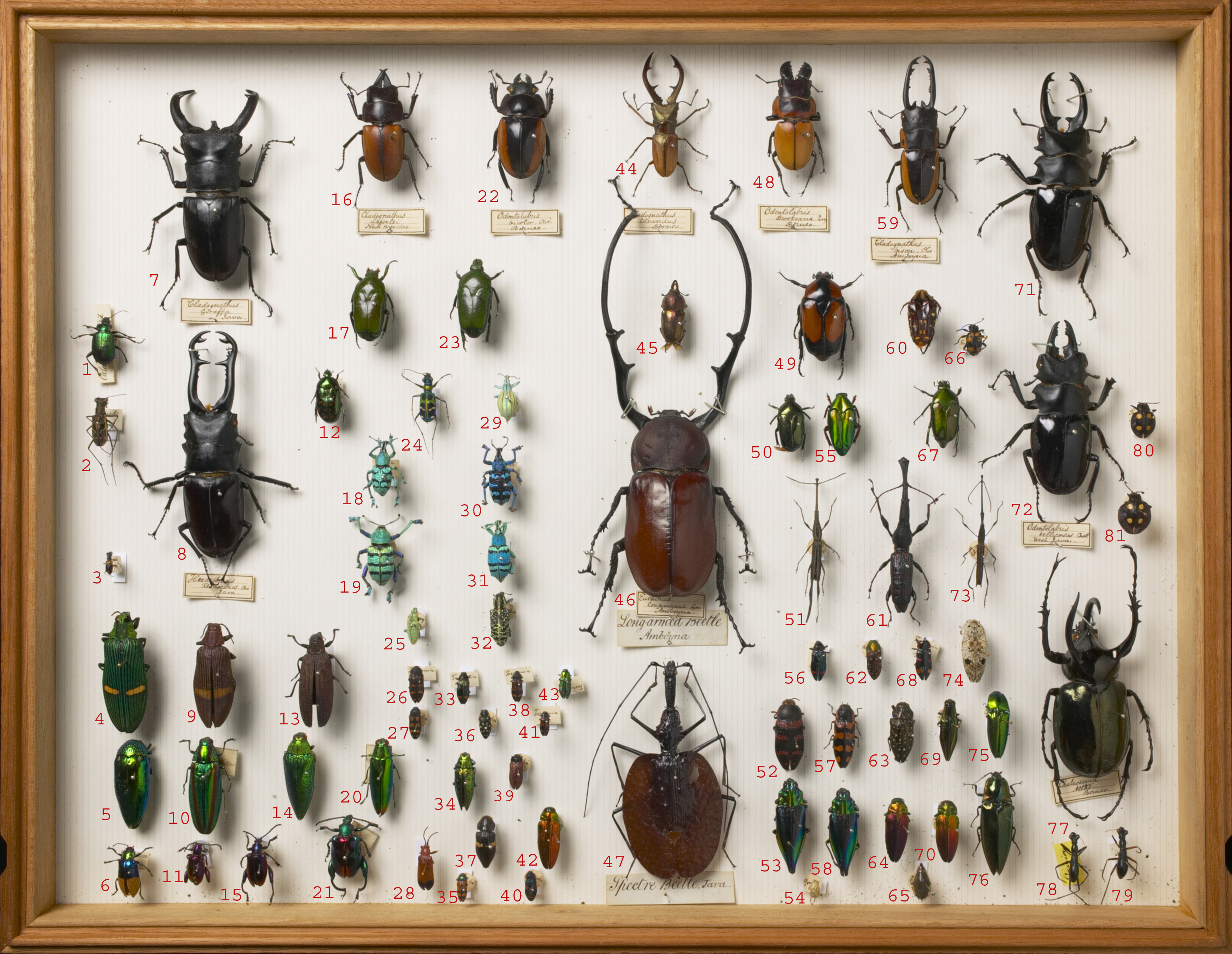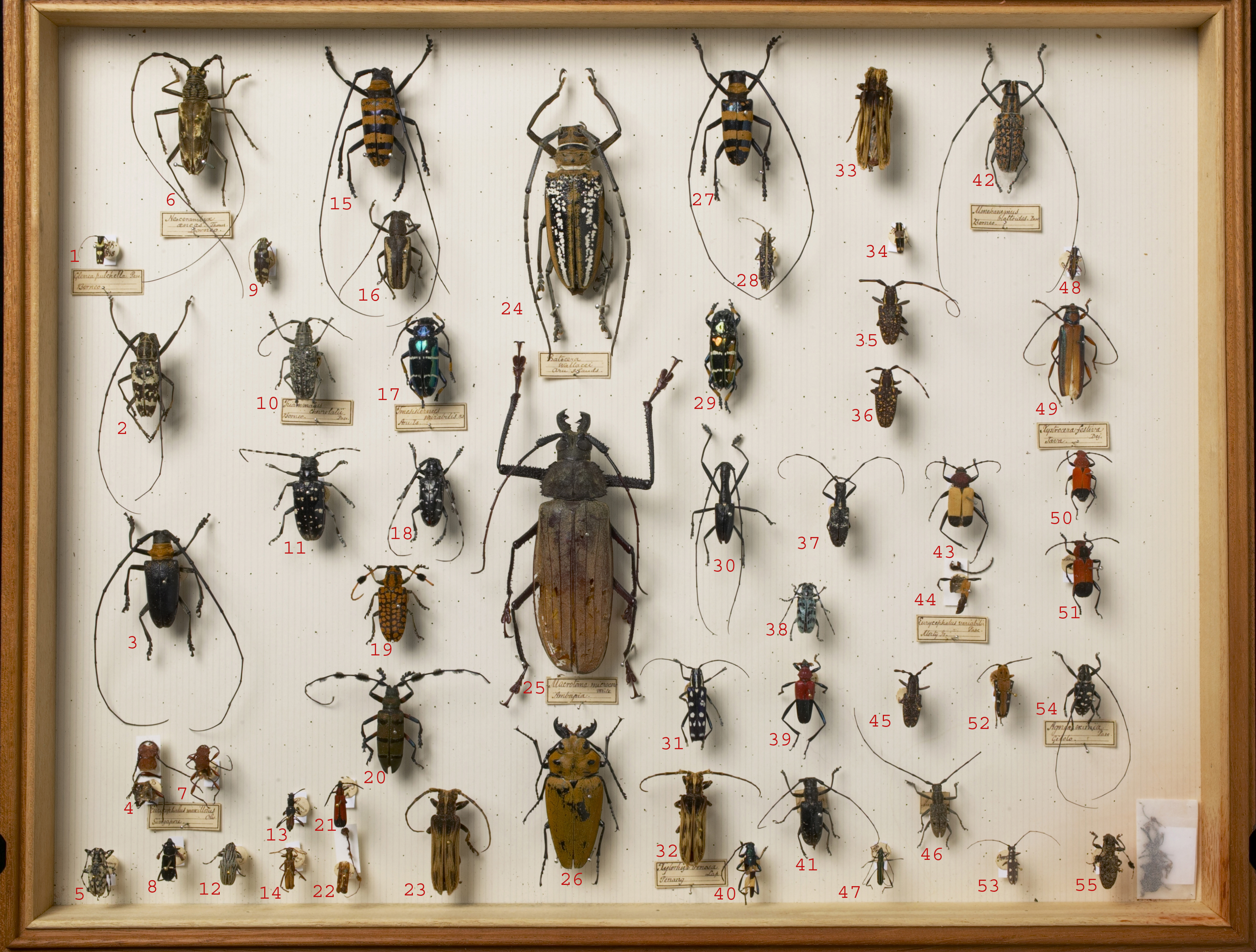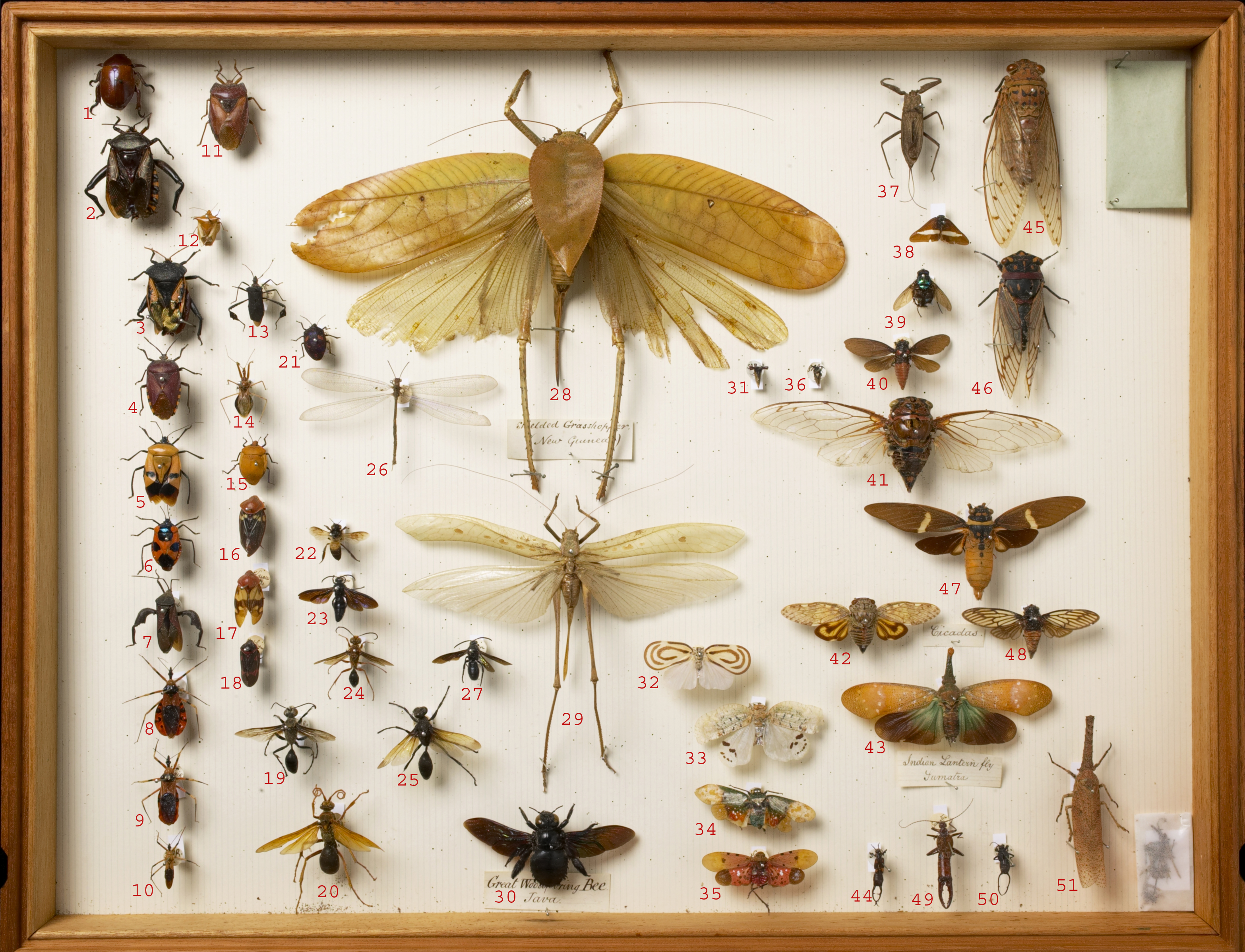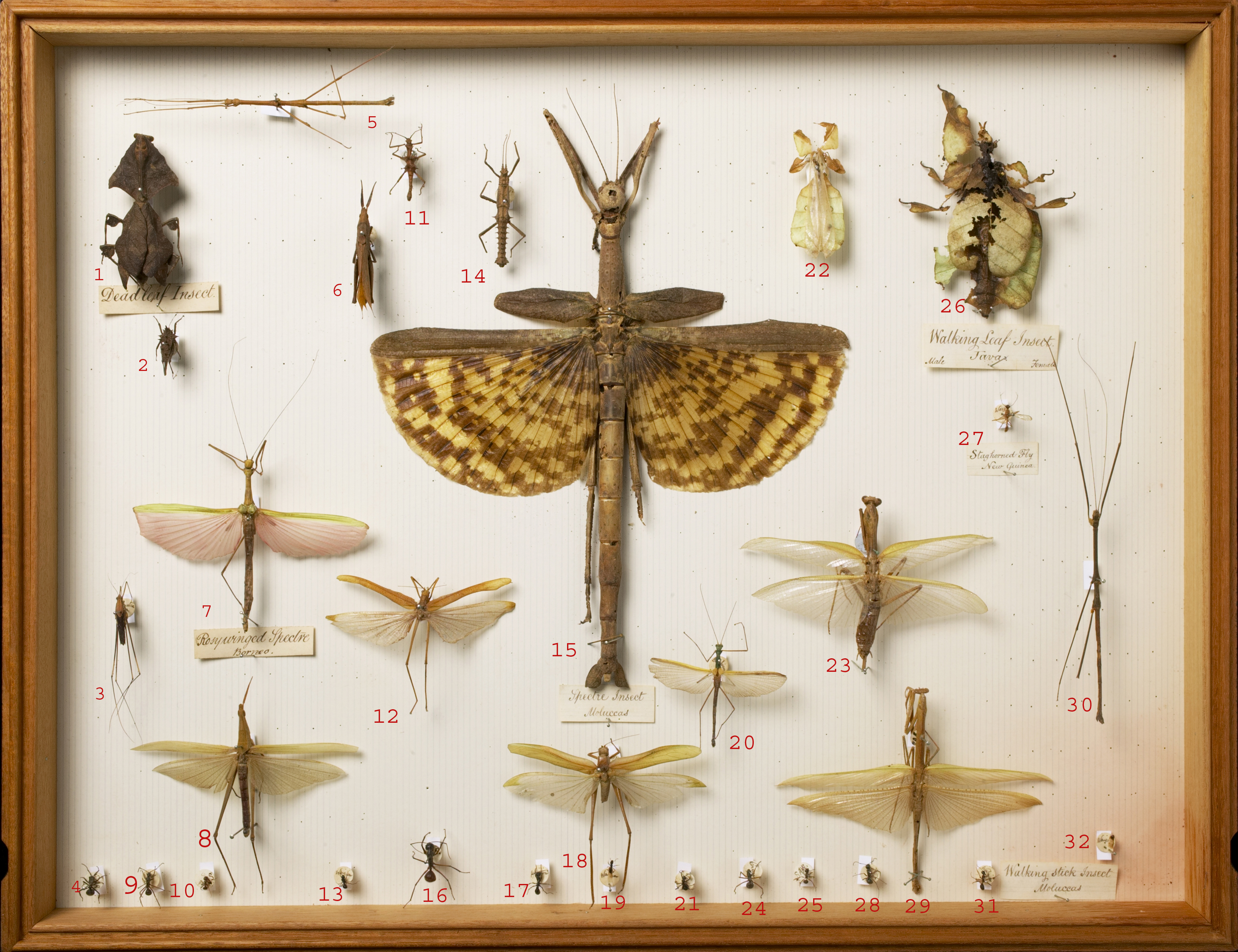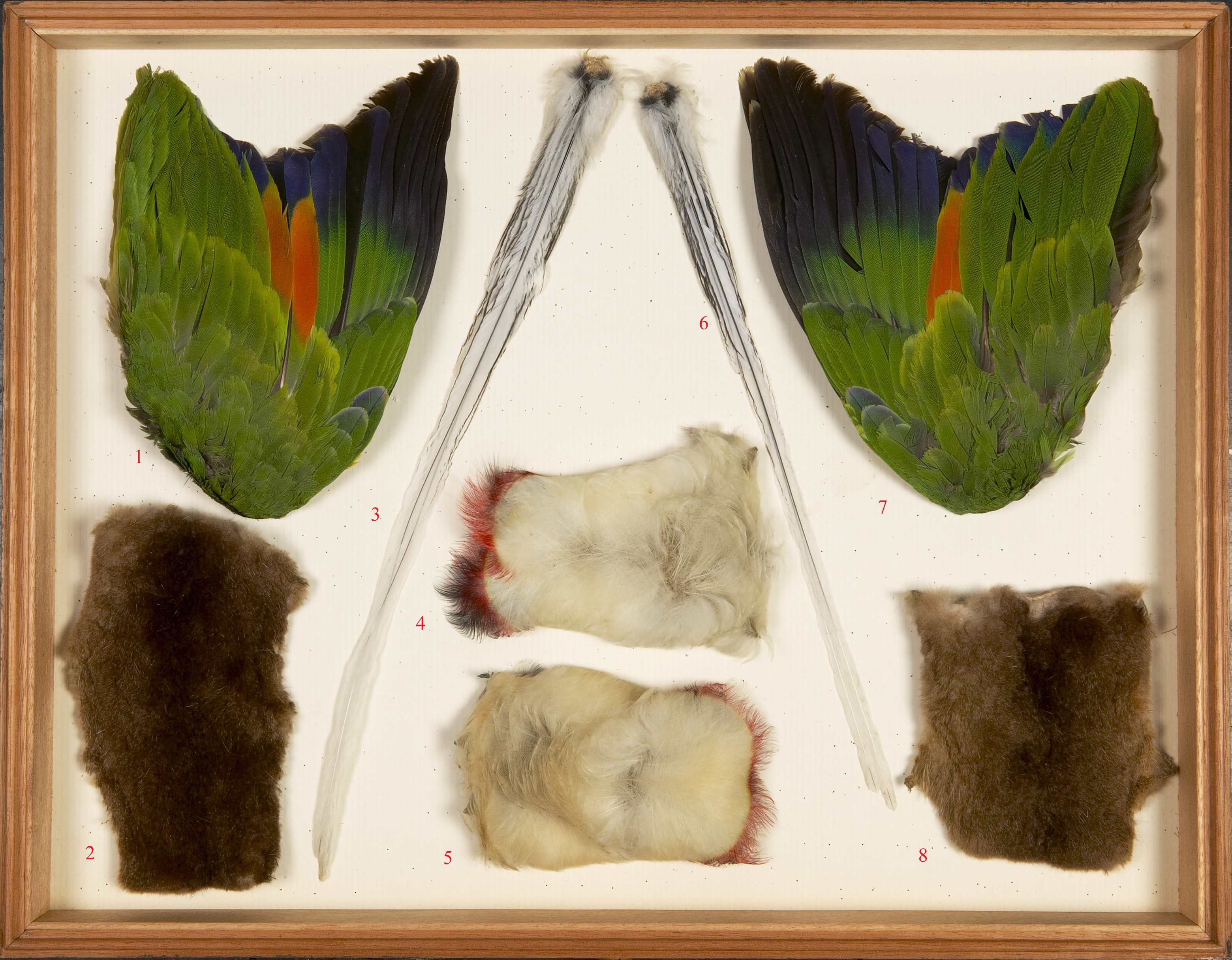ALFRED RUSSEL WALLACE'S PRIVATE COLLECTION IN LONDON'S NATURAL HISTORY MUSEUM: AN ILLUSTRATED CATALOGUE
[Work In Progress]
By George Beccaloni PhD
(Director of the A. R. Wallace Correspondence Project, and former curator of the collection discussed below)
March 2020
INTRODUCTION
This collection represents a small sample of Wallace's extensive private insect collection, which he sold around 1870. Wallace kept these specimens to remind him of his travels in South America and south-east Asia.
Although it is commonly believed that Wallace’s main reason for undertaking his trips to South America and south-east Asia was to earn money by collecting specimens for sale to private collectors and museums, Wallace himself regarded this as a secondary objective. Instead he kept most of the best specimens he found for his private collection and only sold duplicate specimens to earn cash to cover his expenses.
"From my first arrival in the East I had determined to keep a complete set of certain groups from every island or distinct locality which I visited for my own study on my return home, as I felt sure they would afford me very valuable materials for working out the geographical distribution of animals in the archipelago, and also throw light on various other problems. These various sets of specimens were sent home regularly with the duplicates for sale, but either packed separately or so distinctly marked "Private" that they could be easily put aside till my return home. The groups thus reserved were the birds, butterflies, beetles, and land-shells, and they amounted roughly to about three thousand bird skins of about a thousand species, and, perhaps, twenty thousand beetles and butterflies of about seven thousand species." (Wallace, A. R., 1908. My Life: a Record of Events and Opinions. Chapman & Hall.)
During the first five years following his return to England from the south-east Asia, Wallace published important scientific articles on south-east Asian swallowtail butterflies (Papilionidae), pierid butterflies (Pieridae) and chafer beetles (Cetoniinae), and in these he named many new species. However, his interest in taxonomy then waned:
“...I found that I could not now feel sufficient interest in any branch of systematic zoology to devote myself to the minute study required for the classification and description of any important portion of my collections.”...”...if I had not had wider and more varied interests - evolution, distribution, physical geography, anthropology, the glacial period, geological time, sociology, and several others - I might have spent the rest of my life upon similar work, for which my own collection afforded ample materials.” (Wallace, 1908. My Life.)
Around 1867 Wallace began to sell his private collections, keeping for himself
“...only a few boxes of duplicates to serve as mementoes.” (Wallace, 1908. My Life).
It is these "mementoes" which London's Natural History Museum (NHM) obtained from the Wallace family in 2002 and 2005 and which are featured on this page.
CONTENTS OF THE COLLECTION
This collection consists of 28 drawers containing a total of 858 pinned insect specimens, plus one drawer containing 8 pieces of bird and mammal skin. The latter drawer also originally contained a specimen of Fork-tailed Woodnymph hummingbird (Thalurania furcata furcatoides) from Pará in Brazil, which is now in the NHM's bird collection at Tring.
Many of the specimens in this collection were personally collected by Wallace and his assistant Charles Allen, but others must have either been given to Wallace or purchased by him, since they are not from places that he or Allen ever visited (e.g. Japan, Hong Kong, Australia, and South Africa).
The collection was acquired from the Wallace family in two parts as follows:
A. Butterflies and moths, plus a drawer containing pieces of bird and mammal skin (drawers 1-24 and 29)
This was the first part of the Wallace collection to be acquired by the Museum. It was purchased by the Museum from the Wallace family in February 2002, together with the collection of books and manuscripts (6000 items). It consists of 24 drawers of butterfly and moth specimens (639 specimens in total), plus one drawer containing 8 pieces of bird and mammal skin. This part of the collection contains specimens of butterflies and moths collected by Wallace in South America and south-east Asia, plus specimens collected by others in countries he never visited. Highlights of the collection include displays set up by Wallace to illustrate sexual dimorphism (i.e. where males and females of a species differ in wing pattern) and mimicry in butterflies - two areas of research which Wallace made major theoretical contributions to.
The specimens in this part of the collection were originally housed in drawers in a combination bookcase/insect cabinet which is reputed to have been made for Wallace by his brother John. The Wallace family did not, however, want to sell this piece of furniture, so I transferred the specimens from it into NHM Entomology accessions-style drawers, retaining Wallace's original arrangement of the specimens. It was the family's wish that the specimens should remain together with the books and manuscripts, so the NHM constructed a cabinet in the style of the original, in order that all the material purchased from the family could be housed in one unit.
For more information see THIS ARTICLE.
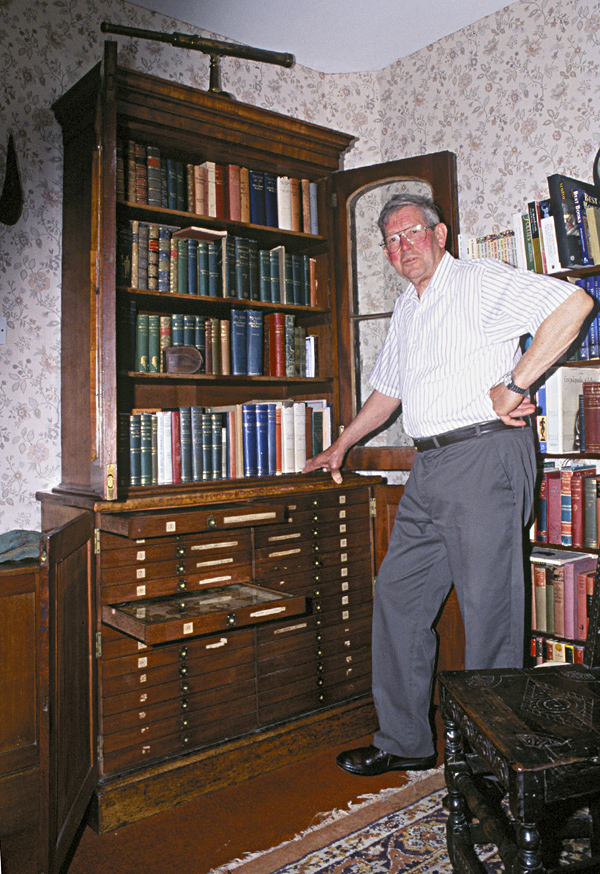
Wallace's grandson Richard beside his grandfather's insect cabinet.
B. Other insects (drawers 25 - 28)
The second part of the collection was discovered by Wallace's grandson Richard in his attic in late 2005 in two entomological store boxes. He donated the specimens to the Museum with the proviso that they were kept with the butterfly and moth specimens which the museum had purchased previously from the family. The collection consists of 219 beetles, bugs, stick insects, earwigs, bush-crickets, grasshoppers, praying mantids, wasps, ants and flies, which are now housed in four drawers in the same cabinet as the butterfly and moth specimens. Wallace's original arrangement of the specimens has been kept. Unfortunately many of them had been extensively damaged by at least four different species of insect pests during the long period they were stored in the attic. Although legs and other appendages had fallen off many of the specimens, the pests had generally not damaged the cuticle (exoskeleton) of the insects. I was therefore able to glue many of the specimens back together using archival quality neutral pH PVA adhesive.

All the specimens in this part of the collection are from south-east Asia. Many were collected by Wallace and his assistant Charles Allen, but others must have either been purchased by Wallace or given to him, since they are not from places that he or Allen visited (e.g. Penang, Malaysia).
This portion of the collection includes some of the most spectacular insect species that Wallace discovered in South-East Asia, such as the huge longhorn beetle Batocera wallacei, in addition to several of the actual specimens illustrated by woodcuts in the famous book of his travels, The Malay Archipelago.
THE COLLECTION
Notes:
- To enlarge a drawer image, click on it and then zoom in.
- The locality information (if any) on the data labels pinned under the specimens is given at the start of the entry for the specimen.
- Many taxonomists have kindly helped to identify the specimens below and their names are given in "[]" after the species name. The identification process is ongoing and if you are certain you can identifiy a previously unidentified specimen, or can correct an existing identification, then please get in touch with me, George Beccaloni (g.beccaloni@gmail.com)
*DRAWER 1*
Birdwing butterflies (Papilionidae) from Asia and Australasia
1. Queensland, Australia - Ornithoptera richmondia Gray, 1853. ♂ [J. Nielsen]
2. [no locality] - Ornithoptera croesus Wallace, 1859. ♂ [J. Tennent]
3. Ambon Island, Indonesia - almost certainly Troides oblongomaculatus oblongomaculatus Goeze, 1779. ♂ [J. Tennent]
4. [no locality] - Ornithoptera probably poseidon. ♀ [J. Nielsen]
5. Philippines - Troides rhadamantus Lucas, 1835. ♂ [J. Tennent]
6. Philippines - Troides rhadamantus Lucas, 1835. ♀ [J. Tennent]
7. Assam, India - Troides aeacus Felder, 1860. ♂ [J. Tennent]
FURTHER INFORMATION
Probably the most famous of the one hundred and thirty species and subspecies of butterflies which Wallace named from south-east Asia, is the magnificent golden-orange birdwing butterfly he christened Ornithoptera croesus (Crösus was a mythological king famed for his wealth). A male of this species can be seen in the middle left of this drawer (specimen number 2).
Wallace caught the first male specimen in 1859 whilst on the Indonesian island of Batchian (Bacan) and the rapturous account he gave of its capture has since become legendary:
“The beauty and brilliancy of this insect are indescribable, and none but a naturalist can understand the intense excitement I experienced when I at length captured it. On taking it out of my net and opening the glorious wings, my heart began to beat violently, the blood rushed to my head, and I felt much more like fainting than I have done when in apprehension of immediate death. I had a headache the rest of the day, so great was the excitement produced by what will appear to most people a very inadequate cause.” (Wallace, 1869. The Malay Archipelago.)
Apparently Wallace’s book The Malay Archipelago was one of the most important influences on the writings of novelist Joseph Conrad, who probably even based a passage in Lord Jim on Wallace’s account of his capture of croesus. Conrad gives these words to the merchant and entomologist Stein:
“One step. Steady. Another step. Flop! I got him! When I got up I shook like a leaf with excitement, and when I opened these beautiful wings and made sure what a rare and so extraordinary perfect specimen I had, my head went round and my legs became weak with emotion that I had to sit on the ground. I had greatly desired to possess myself of a specimen of that species when collecting for the professor. I took long journeys and underwent great privations; I had dreamed of him in my sleep, and here suddenly I had him in my fingers – for myself!”
In England croesus rapidly became highly sought after by collectors - the high cost of specimens reflecting the species’ scarcity and desirability. For example, in 1860 the Museum purchased 2 pairs of croesus from Wallace’s agent Samuel Stevens. Each pair cost £6.00, which equates to about £280 in today’s currency!
*DRAWER 2*
Swallowtail butterflies (Papilionidae) from Asia
1. Assam, India - Atrophaneura varuna astorion Westwood, 1842. ♂ [J. Tennent]
2. Philippines - Atrophaneura semperi Felder, 1861. ♂ [J. Tennent]
3. Philippines - Atrophaneura semperi Felder, 1861. ♀ [J. Tennent]
4. Darjeeling, India - Atrophaneura polyeuctes polyeuctes Doubleday, 1842. ♂ [J. Tennent]
5. Silhot[?] - Atrophaneura dasarada dasarada Doubleday, 1842 [J. Tennent]
6. Darjeeling, India - Atrophaneura dasarada dasarada Doubleday, 1842 [J. Tennent]
7. N. India - Atrophaneura coon doubledayi Wallace, 1865. ♂ [J. Tennent]
8. India - Pachliopta hector Linnaeus, 1758. ♂ [J. Tennent]
9. Java Island, Indonesia - Pachliopta aristolochiae adamas Zinken, 1831 [J. Tennent]
10. Philippines - Pachliopta aristolochiae antiphus Fabricius, 1793 [J. Tennent]
11. Watubela Islands, Indonesia - Pachliopta polydorus polydorus Linnaeus, 1763 [J. Tennent]
*DRAWER 3*
Swallowtail butterflies (Papilionidae) from Asia
1. India - Papilio protenor euprotenor Fruhstorfer, 1908. ♂ [J. Tennent]
2. Assam, India - Papilio protenor euprotenor Fruhstorfer, 1908. ♀ [J. Tennent]
3. Hong Kong - Papilio bianor bianor Cramer, 1776. ♂ [J. Tennent]
4. Sylhet[?] - Papilio polyctor ganesa Doubleday, 1842 [J. Tennent]
5. Nepal[?] - Papilio polyctor ?polyctor Boisduval, 1836 [J. Tennent]
6. Silhet[?]- Papilio polyctor ?polyctor Boisduval, 1836 [J. Tennent]
7. Silhet[?] - Papilio arcturus arius Rothschild, 1908 [J. Tennent]
8. Darjeeling, India - Papilio paris paris Linnaeus, 1758 [J. Tennent]
9. Java Island, Indonesia - Papilio paris arjuna Horsfield, 1828 [J. Tennent]
10. Sumatra Island, Indonesia - Papilio paris arjuna Horsfield, 1828 [J. Tennent]
11. Philippines - Papilio palinurus daedalus C & R Felder, 1861 [J. Tennent]
12. Gunung Ledang, Malaysia - Papilio palinurus palinurus Fabricius, 1787 [J. Tennent]
*DRAWER 4*
Swallowtail butterflies (Papilionidae) from Asia
1. Sumatra Island, Indonesia - Papilio memnon anceus Cramer, 1779 [J. Tennent]
2. Sumatra Island, Indonesia - Papilio memnon anceus Cramer, 1779. ♀ [J. Tennent]
3. Java Island, Indonesia - Papilio memnon memnon Linnaeus, 1758 [J. Tennent]
4. Java Island, Indonesia - Papilio memnon memnon Linnaeus, 1758 [J. Tennent]
5. Philippines - Papilio rumanzovia Eschscholtz, 1821. ♂ [J. Tennent]
6. Philippines - Papilio rumanzovia Eschscholtz, 1821. ♀ [J. Tennent]
7. Philippines - Papilio rumanzovia Eschscholtz, 1821. ♂ [J. Tennent]
8. Bacan Island, Indonesia - ?Papilio rumanzovia Eschscholtz, 1821 (but this species is confined to the Philippines) [J. Tennent]
9. Bacan Island, Indonesia - ?Papilio rumanzovia Eschscholtz, 1821 (but this species is confined to the Philippines) [J. Tennent]
10. India - Papilio memnon memnon Linnaeus, 1758 [J. Tennent]
11. Malacca, Malaysia - Papilio memnon memnon Linnaeus, 1758 [J. Tennent]
*DRAWER 5*
Swallowtail butterflies (Papilionidae) from Asia and Australasia
1. West Timor Island, Indonesia - Papilio polytes timorensis C & R Felder, 1864. ♂ [J. Tennent]
2. Sumatra Island, Indonesia - Papilio polytes theseus Cramer, 1779. ♀ [J. Tennent]
3. Nepal - Papilio polytes polytes Linneaus, 1758. ♂ [J. Tennent]
4. China - Papilio polytes polytes Linneaus, 1758. ♀ [J. Tennent]
5. N. India - Papilio polytes ?romulus Cramer, 1776. ♀ [J. Tennent]
6. Manila, Philippines - Papilio alphenor ledebouria Eschscholtz, 1821. ♂ [J. Tennent]
7. Philippines - Papilio alphenor ledebouria Eschscholtz, 1821. ♀ [J. Tennent]
8. Bacan Island, Indonesia - Papilio alphenor ?nicanor C & R Felder, 1864. ♂ [J. Tennent]
9. Bacan Island, Indonesia - Papilio alphenor ?nicanor C & R Felder, 1864. ♀ [J. Tennent]
10. India - Papilio castor Westwood, 1842 [J. Tennent]
11. Australia - Papilio aegeus aegeus Donovan, 1805. ♂ [J. Tennent]
12. Australia - Papilio aegeus aegeus Donovan, 1805. ♂ [J. Tennent]
13. Queensland, Australia - Papilio aegeus aegeus Donovan, 1805. ♀ [J. Tennent]
14. India - Papilio nephelus chaon Westwood, 1845. ♂ [J. Tennent]
15. Assam, India - Papilio helenus helenus Linnaeus, 1758. ♂ [J. Tennent]
16. Philippines - Papilio hystaspes C & R Felder, 1862. ♂ [J. Tennent]
17. Bacan Island, Indonesia - Papilio fuscus ?lapathus Fruhstorfer, 1904. ♀ [J. Tennent]
*DRAWER 6*
Swallowtail butterflies (Papilionidae) from Asia and Australasia
1. Singapore - Papilio demolion demolion Cramer, 1779 [J. Tennent]
2. Queensland, Australia - Papilio demoleus sthenelus McLeay, 1826 [J. Tennent]
3. Moreton Bay, Queensland, Australia - Papilio anactus McLeay, 1826 [J. Tennent]
4. Northern India - Chilasa clytia clytia Linnaeus, 1758 [J. Tennent]
5. West Timor Island, Indonesia - Chilasa clytia echidna Boisduval, 1836 [J. Tennent]
6. Silhet[?] - Chilasa clytia clytia Linnaeus, 1758 [J. Tennent]
7. Silhet[?] - Chilasa clytia clytia Linnaeus, 1758 [J. Tennent]
8. Malabar, India - Graphium ramaceus Westwood, 1872 (1841?) (drawer label says pollux (Westwood, 1842)) [J. Tennent]
9. Darjeeling, India - Graphium xenocles Doubleday, 1842. ♂ [J. Tennent]
10. India - Graphium macareus Godart, 1819 [J. Tennent]
11. Gunung Ledang, Malaysia - Graphium delessertii delessertii Guérin-Méneville, 1839 [J. Tennent]
12. Queensland, Australia - Graphium macleayanus macleayanus Leach, 1814. ♂ [J. Tennent]
13. Assam, India - Pazala glycerion glycerion Gray, 1813 [J. Tennent]
14. Sumatra Island, Indonesia - Pathysa antiphates itamputi Butler, 1885 [J. Tennent]
15. Queensland, Australia - Protographium leosthenes Doubleday, 1846 [J. Tennent]
16. [no locality] - Pathysa rhesus Boisduval, 1836 [J. Tennent]
*DRAWER 7*
Swallowtail butterflies (Papilionidae) from Asia and Australasia
1. Waigeo Island, Irian Jaya, Indonesia - Graphium codrus medon C & R Felder, 1864 [J. Tennent]
2. Assam, India - Graphium cloanthus cloanthus Westwood, 1841 [J. Tennent]
3. Java Island, Indonesia - Graphium sarpedon sarpedon Linnaeus, 1758 [J. Tennent]
4. Bacan Island, Indonesia - Graphium milon dodingensis Rothschild, 1896 [J. Tennent]
5. Queensland, Australia - Graphium sarpedon choredon C & R Felder, 1864 [J. Tennent]
6. Bacan Island, Indonesia - Graphium (Graphium) euryplus [J. Nielsen]
7. India - Graphium sp. [J. Tennent]
8. Queensland, Australia - Graphium eurypylus lycaon C & R Felder, 1865 [J. Tennent]
9. Assam, India - Graphium bathycles chiron Wallace, 1865 [J. Tennent]
10. Gunung Ledang, Malaysia - Graphium bathycles bathycloides Honrath, 1884 [J. Tennent]
11. Seram Island, Indonesia - Graphium agamemnon plisthenes C & R Felder, 1865 [J. Tennent]
12. Manila, Philippines - Graphium agamemnon agamemnon Linnaeus, 1758 [J. Tennent]
13. Singapore - Lamproptera curius curius Fabricius, 1787 [J. Tennent]
14. Moreton Bay, Queensland, Australia - Cressida cressida Fabricius, 1775. ♂ [J. Tennent]
15. Queensland, Australia - Cressida cressida Fabricius, 1775. ♂ [J. Tennent]
16. Queensland, Australia - Cressida cressida Fabricius, 1775. ♀ [J. Tennent]
*DRAWER 8*
Swallowtail butterflies (Papilionidae) from the Americas
1. [no locality] - Protesilaus telesilaus telesilaus (C. Felder & R. Felder, 1864). ♂ [A. Neild]
2. California, USA -
3. Bogotá, Colombia - Eurytides columbus (Kollar, 1850). ♂ [A. Neild]
4. [no locality] - Eurytides dolicaon (Cramer, 1775). ♂ [A. Neild]
5. Canada -
6. Rio Grande[?] - Heraclides hectorides (Esper, 1794). ♂ [A. Neild]
7. Manaus, Brazil - Heraclides torquatus torquatus (Cramer, 1777). ♂ [A. Neild]
8. Pará, Brazil - Heraclides torquatus torquatus (Cramer, 1777). ♀ [A. Neild]
9. Bogotá, Colombia - Pterourus coroebus syndemis Tyler, K. Brown & Wilson, 1994. ♂ [A. Neild]
10. French Guiana[?] - Battus crassus crassus (Cramer, 1777). ♀ [A. Neild]
11. [no locality] - Battus polydamas polydamas (Linnaeus, 1758)
12. Upper Amazon, Brazil - Heraclides anchisiades anchisiades (Esper, 1788). ♂ [A. Neild]
13. Colombia[?] - Mimoides euryleon euryleon (Hewitson, [1856]). ♂ [A. Neild]
14. Rio Grande[?] - Parides agavus (Drury, 1782). ♂ [A. Neild]
15. Capim river, nr Pará[?], Brazil - Parides aeneas aeneas (Linnaeus, 1758). ♂ [A. Neild]
16. [no locality] - Parides aeneas aeneas (Linnaeus, 1758). ♀ [A. Neild]
17. Santarem, Brazil - Parides vertumnus vertumnus (Cramer, 1779). ♂ [A. Neild]
18. [no locality] - Parides vertumnus vertumnus (Cramer, 1779). ♀ [A. Neild]
19. Bogotá, Colombia - Parides erithalion erithalion (Boisduval, 1836). ♂ [A. Neild]
20. Pará, Brazil - Parides mithras mithras (Grose-Smith, 1902)
21. "Serpa"[?] - Parides echemon ergeteles (G. Gray, [1853]). ♂ [A. Neild]
22. [no locality] - Parides echemon echemon (Hübner, [1813]). ♂ [A. Neild]
23. [no locality] - Parides echemon echemon (Hübner, [1813]). ♀ [A. Neild]
24. Pará, Brazil - Parides lysander parsodes (G. Gray, [1853]). ♂ [A. Neild]
25. Pará, Brazil - Parides lysander parsodes (G. Gray, [1853]). ♀ [A. Neild]
*DRAWER 9*
White and sulphur butterflies (Pieridae) from many world regions
1. Bali Island, Indonesia - Leptosia nina chlorographa Hübner, 1818 [J. Tennent]
2. Aru Islands[?], Indonesia -
3. West Timor Island, Indonesia - Eurema brigitta dionysia Hulstaert, 1923 (drawer label says drona Horsfeld (Sumatra to Lombok)) [J. Tennent]
4. South Africa -
5. South Africa -
6. South Africa -
7. South Africa -
8. N.W. India -
9. Moreton Bay, Queensland, Australia - Appias paulina ega Boisduval, 1836. ♂ [J. Tennent]
10. Moreton Bay, Queensland, Australia - Appias paulina ega Boisduval, 1836. ♀ [J. Tennent]
11. Darjeeling, India - Appias ?pandione Geyer, 1832 [J. Tennent]
12. Philippines - Appias sp. [J. Tennent]
13. Tocantins river, Brazil -
14. Tocantins river, Brazil -
15. Tocantins river, Brazil -
16. [no locality] -
17. N. India - Prioneris philonome clemanthe Doubleday, 1846 [J. Tennent]
18. [no locality] - Prioneris thestylis Doubleday, 1842 [J. Tennent]
19. India - Delias pasithoe Linnaeus, 1767 [J. Tennent]
20. India - Delias pasithoe Linnaeus, 1767 [J. Tennent]
21. South Australia - Delias aganippe Donovan, 1805. ♂ [J. Tennent]
22. South Australia - Delias aganippe Donovan, 1805 [J. Tennent]
23. Philippines - Delias henningia Eschscholtz, 1821 [J. Tennent]
24. India - Delias belladonna Fabricius, 1793 [J. Tennent]
25. India - Delias belladonna Fabricius, 1793 [J. Tennent]
26. Sarawak, Malaysia - Delias sp. [J. Tennent]
27. Darjeeling, India - Delias acalis Godart, 1819 [J. Tennent]
28. India - Delias eucharis Drury, 1773 [J. Tennent]
29. Australia - Delias mysis mysis Fabricius, 1775 [J. Tennent]
30. Moreton Bay, Queensland, Australia - Delias argenthona argenthona Fabricius, 1793. ♂ [J. Tennent]
31. Bacan Island, Indonesia - Cepora aspasia emma van Vollenhoven, 1865 [J. Tennent]
32. West Timor Island, Indonesia - Belenois java Sparmann, 1767 [J. Tennent]
33. Bali Island, Indonesia - Belenois java Sparmann, 1767 [J. Tennent]
34. Australia - Delias nigrina Fabricius, 1775. ♂ [J. Tennent]
35. Queensland, Australia - Delias nigrina Fabricius, 1775. ♀ [J. Tennent]
36. India - Appias nero galba Wallace, 1867 [J. Tennent]
37. Java Island, Indonesia - Appias nero nero Fabricius, 1793 [J. Tennent]
38. Philippines - Appias nero Fabricius, 1793 [J. Tennent]
*DRAWER 10*
White and sulphur butterflies (Pieridae) from many world regions
1. N. India - Pareronia avatar Moore, 1857 [J. Tennent]
2. Philippines - Pareronia boebera Eschscholtz, 1821. ♂ [J. Tennent]
3. Philippines - Pareronia boebera Eschscholtz, 1821. ♀ [J. Tennent]
4. Bacan Island, Indonesia - Pareronia argolis ?argolis C & R Felder, 1861. ♂ [J. Tennent]
5. Seram Island, Indonesia - Pareronia argolis ?argolis C & R Felder, 1861. ♂ [J. Tennent]
6. Makassar, Sulawesi Island, Indonesia - Pareronia tritaea tritaea C & R Felder, 1859. ♂ [J. Tennent]
7. South Africa -
8. [no locality] -
9. South Africa -
10. Tocantins river, Brazil -
11. Sussex, UK - Gonepteryx rhamni Linnaeus, 1758. ♂ [J. Tennent]
12. Sarawak, Malaysia - Dercas verhuelli herodorus Fruhstorfer, 1910 [J. Tennent]
13. India - Ixias marianne Cramer, 1779 [J. Tennent]
14. West Timor Island, Indonesia - Hebomoia glaucippe timorensis Wallace, 1863. ♂ [J. Tennent]
15. Darjeeling, India - Hebomoia glaucippe Linnaeus, 1758. ♂ [J. Tennent]
16. Makassar, Sulawesi Island, Indonesia - Hebomoia glaucippe celebensis Wallace, 1863. ♂ [J. Tennent]
17. Philippines - Hebomoia glaucippe Linnaeus, 1758. ♀ [J. Tennent]
18. Borneo - Ixias undatus Butler, 1871 [J. Tennent]
19. India - Ixias pyrene Linnaeus, 1764 [J. Tennent]
20. Queensland, Australia - Catopsilia scylla gorgophone Boisduval, 1836. ♂ [J. Tennent]
21. Queensland, Australia - Catopsilia scylla gorgophone Boisduval, 1836. ♀ [J. Tennent]
22. Bacan Island, Indonesia - Catopsilia pomona Fabricius, 1775. ♂ [J. Tennent]
23. Sarawak, Malaysia - Catopsilia pomona Fabricius, 1775. ♂ [J. Tennent]
24. Gunung Ledang, Malaysia - Catopsilia pomona Fabricius, 1775. ♂ [J. Tennent]
25. West Timor Island, Indonesia - Catopsilia pomona Fabricius, 1775 [J. Tennent]
26. Santarem, Brazil -
27. Amazon, Brazil -
*DRAWER 11*
Milkweed butterflies (Nymphalidae: Danainae) from Asia, Austalasia and South America
1. Darjeeling, India -
2. Monte Alegre, Brazil -
3. Watubela Islands, Indonesia -
4. Maluku Islands, Indonesia - “Danaus affinis” [J. Tennent]
5. Darjeeling, India -
6. Moreton Bay, Queensland, Australia - Tirumala hamata hamata Macleay, 1826 [J. Tennent]
7. Penang, Malaysia -
8. Sarawak, Malaysia -
9. Singapore -
10. Singapore -
11. India -
12. Philippines -
13. Makassar, Sulawesi Island, Indonesia -
14. Sulawesi Island, Indonesia -
15. Malacca, Malaysia -
16. Sumatra Island, Indonesia -
17. Sarawak, Malaysia -
18. Moreton Bay, Queensland, Australia - Euploea corinna Macleay, 1826 [J. Tennent]
19. Philippines -
*DRAWER 12*
Milkweed butterflies (Nymphalidae: Danainae) and relatives from Asia
1. Sumatra Island, Indonesia -
2. Java Island, Indonesia -
3. Sri Lanka -
4. Makassar, Sulawesi Island, Indonesia -
5. Seram Island, Indonesia -
6. Philippines -
7. Sarawak, Malaysia -
8. Aru Islands, Indonesia -
9. Kai Islands, Indonesia -
10. Teluk Dore, Irian Jaya, Indonesia -
11. Seram Island, Indonesia -
12. Sumatra Island, Indonesia -
13. Sumatra Island, Indonesia -
*DRAWER 13*
Mixed butterflies and moths from Asia and Austalasia
1. Java Island, Indonesia - Cricula trifenestrata (Helfer, 1837) [M. R. Honey]
2. Java Island, Indonesia - Trabala sp. probably krishna, Roepke, 1951 [M. R. Honey]
3. Java Island, Indonesia - Kunugia dora (Swinhoe, 1893) [M. R. Honey]
4. Java Island, Indonesia - ?Episteme maculatrix (Westwood, 1841)
5. Seram Island, Indonesia - Eumelea sp. [M. R. Honey]
6. Makassar, Sulawesi Island, Indonesia - Pompelon marginata (Guérin-Méneville, 1843) [M. R. Honey]
7. Bacan Island, Indonesia - ?Ophthalmis cincta (Boisduval, 1874) [M. R. Honey]
8. Makassar, Sulawesi Island, Indonesia - Euchromia polymena (Linnaeus, 1758) [M. R. Honey]
9. Java Island, Indonesia - Caeneressa diaphana (Kollar, 1848) [M. R. Honey]
10. Java Island, Indonesia - Caeneressa diaphana (Kollar, 1848) [M. R. Honey]
11. Misoöl Island, Irian Jaya, Indonesia - Comella laetifica (Felder, 1864) [M. R. Honey]
12. Halmahera Island, Indonesia - ?Callidula evander (Cramer, 1782) [M. R. Honey]
13. Kai Islands, Indonesia - Callidula clavata (Pagenstecher, 1887) [M. R. Honey]
14. Singapore - Ticherra acte liviana Fruhstorfer, 1912 [J. Tennent]
15. Misoöl Island, Irian Jaya, Indonesia - Danis sp. [J. Tennent]
16. Bacan Island, Indonesia - Danis sp. [J. Tennent]
17. Misoöl Island, Irian Jaya, Indonesia - Danis sp. [J. Tennent]
18. Halmahera Island, Indonesia - Arhopala sp. [J. Tennent]
19. Waigeo Island, Irian Jaya, Indonesia - Arhopala sp. [J. Tennent]
20. Waigeo Island, Irian Jaya, Indonesia - Arhopala sp. [J. Tennent]
21. Java Island, Indonesia - Erebus ephesperis (Hübner, 1827) [M. R. Honey]
22. New Guinea - ?Comella laetifica (Felder, 1864) [M. R. Honey]
23. Aru Islands, Indonesia - Hypochrysops sp. [J. Tennent]
24. Sumatra Island, Indonesia - ?Hypochrysops sp. [J. Tennent]
25. [no locality] - Attacus atlas (Linnaeus, 1758). ♂ [M. R. Honey]
26. [no locality] - Attacus atlas (Linnaeus, 1758). ♀ [M. R. Honey]
27. Malacca, Malaysia - Lyssa zampa (Butler, 1869) [M. R. Honey]
28. Halmahera Island, Indonesia - ?Callidula evander (Cramer, 1782) [M. R. Honey]
29. Aru Islands, Indonesia - ?Hypochrysops sp. [J. Tennent]
30. Aru Islands, Indonesia - ?Hypochrysops sp. [J. Tennent]
31. Misoöl Island, Irian Jaya, Indonesia - ?Hypochrysops sp. [J. Tennent]
32. Aru Islands, Indonesia - ?Hypochrysops sp. [J. Tennent]
33. Waigeo Island, Irian Jaya, Indonesia - ?Hypochrysops sp. [J. Tennent]
34. Makassar, Sulawesi Island, Indonesia - ?Hypochrysops sp. [J. Tennent]
35. Waigeo Island, Irian Jaya, Indonesia - ?Hypochrysops sp. [J. Tennent]
36. Sumatra Island, Indonesia - Arhopala sp. [J. Tennent]
37. Halmahera Island, Indonesia - ?Hypochrysops sp. [J. Tennent]
38. Sumatra Island, Indonesia - Spindasis lohita senama Fruhstorfer, 1912 [J. Tennent]
39. Bacan Island, Indonesia - Alcides orontes (Linnaeus, 1763) [M. R. Honey]
40. [no locality] - Amesia aliris (Doubleday, 1847) [M. R. Honey]
41. Bacan Island, Indonesia - Dysphania sp. [M. R. Honey]
42. Seram Island, Indonesia - Celerana perithea (Cramer, 1777) [M. R. Honey]
43. Java Island, Indonesia - Dysphania sp. [M. R. Honey]
44. [no locality] - Cyclosia papilionaris (Drury, 1773) [M. R. Honey]
45. Java Island, Indonesia - Cyclosia pieridoides (Herrich-Schäffer, 1854) [M. R. Honey]
46. Makassar, Sulawesi Island, Indonesia - Cyclosia imitans (Butler, 1881) [M. R. Honey]
47. Java Island, Indonesia - Milionia ?stueningi Inoue, 2000 [M. R. Honey]
48. Singapore - Cyclosia midama (Herrich-Schäffer, [1853]) [M. R. Honey]
49. Misoöl Island, Irian Jaya, Indonesia - ?Callidula evander (Cramer, 1782) [M. R. Honey]
50. Kayoa Island, Indonesia - Callidula arctata (Butler, 1877) [M. R. Honey]
51. Seram Island, Indonesia - Danis sp. [J. Tennent]
*DRAWER 14*
Brush-footed butterflies (Nymphalidae) from Asia, the Americas and Africa
1. [no locality] Heliconius melpomene (Linnaeus, 1758). ♂ [A. Neild]
2. India - Heliconius burneyi burneyi (Hübner, [1831]). ♀ [A. Neild]
3. Pará, Brazil - Heliconius melpomene thelxiopeia Staudinger, 1897. ♂ [A. Neild]
4. Capim river, Brazil - Heliconius doris doris (Linnaeus, 1771). ♀ [A. Neild]
5. Santarem, Brazil - Heliconius doris doris (Linnaeus, 1771).
6. Pará, Brazil - Lycorea halia halia (Hübner, 1816) x Lycorea halia discreta Haensch, 190*. ♀ [A. Neild]
7. [no locality] - Heliconius sara (Fabricius, 1793) or Heliconius leucadia H. Bates, 1862 [A. Neild]
8. Monte Alegre, Brazil - Heliconius wallacei wallacei Reakirt, 1866.
9. Bogota, Colombia - Heliconius cydno cydno (E. Doubleday, 1847). ♂ [A. Neild]
10. Rio Grande[? this = state of Rio Grande do Sul] - Heliconius erato phyllis (Fabricius, 1775) or Heliconius melpomene nanna Stichel, 1899 [A. Neild]
11. Pará, Brazil - Heliconius ricini ricini (Linnaeus, 1758)
12. Rio Grande[? this = state of Rio Grande do Sul] - Heliconius ethilla narcaea (Godart, 1819). ♂ [A. Neild]
13. "Rio Sq"[?] - Mechanitis lysimnia lysimnia (Fabricius, 1793). ♂ [A. Neild]
14. [no locality] - Mechanitis sp. possibly M. polymnia polymnia (Linnaeus, 1758). ♀ [A. Neild]
15. Bahia, Brazil - Hypothyris euclea laphria (E. Doubleday, 1847). ♀ [A. Neild]
16. [no locality] - Thyridia psidii (Linnaeus, 1758)
17. Pará, Brazil - Mcclungia cymo cymo (Hübner, [1806]). ♀ [A. Neild]
18. Rio Grande[? this = state of Rio Grande do Sul] - perhaps an Episcada sp. Godman & Salvin, 1879 [A. Neild]
19. Capim river, Brazil - Eueides isabella isabella (Stoll, 1781). ♂ [A. Neild]
20. South Africa -
21. South Africa -
22. South Africa -
23. South Africa -
24. South Africa -
25. South Africa -
26. South Africa -
27. South Africa -
28. South Africa -
29. Java Island, Indonesia -
30. Queensland, Australia - Acraea andromacha andromacha Fabricius, 1775 [J. Tennent]
31. S. Brazil - Eresia lansdorfi (Godart, 1819). ♂ [A. Neild]
*DRAWER 15*
Brush-footed butterflies (Nymphalidae) from Asia
1. Silhet[?] - Cethosia biblis Drury, 1773 [J. Tennent]
2. Darjeeling, India - Cethosia biblis biblis Drury, 1773 [J. Tennent]
3. Silhet[?] - Cethosia penthesilea Cramer, 1777. ♂ [J. Tennent]
4. Silhet[?] - Cethosia penthesilea Cramer, 1777. ♀ [J. Tennent]
5. Silhet[?] - Cethosia penthesilea Cramer, 1777. ♀ [J. Tennent]
6. Java Island, Indonesia - Cethosia hypsea munjava Fruhstorfer, * [J. Tennent]
7. Bacan Island, Indonesia - Vindula arsinoe Cramer, 1777 [J. Tennent]
8. Philippines - Vindula dejone dejone Erichson, * [J. Tennent]
9. Monvido[?] - Parthenos sylvia Cramer, 1775 [J. Tennent]
10. Sumatra Island, Indonesia - Parthenos sylvia lilacinus Butler, * [J. Tennent]
11. Philippines - Zethera hestioides Felder, 1861 [J. Tennent]
12. Java Island, Indonesia - Argynnis hyperbius javanica Oberthür, *. ♂ [J. Tennent]
13. Java Island, Indonesia - Argynnis hyperbius javanica Oberthür, *. ♀ [J. Tennent]
14. India - Argynnis hyperbius hyperbius Linnaeus, 1763. ♀ [J. Tennent]
15. Sumatra Island, Indonesia - Cupha erymanthis nagara Fruhstorfer, * [J. Tennent]
16. Teluk Dore, Irian Jaya, Indonesia - Yoma sp. [J. Tennent]
17. Sumatra Island, Indonesia - Prothoe franck irma Fruhstorfer, * [J. Tennent]
18. Malacca, Malaysia - ?Euthalia sp. [J. Tennent]
19. Sumatra Island, Indonesia - Moduza procris minoe Fruhstorfer, * [J. Tennent]
20. Bacan Island, Indonesia - Phaedyma sp. [J. Tennent]
21. Sumatra Island, Indonesia - Neptis/Athyma sp. [J. Tennent]
22. India - Neptis/Athyma sp. [J. Tennent]
23. Bacan Island, Indonesia - Symbrenthia sp. [J. Tennent]
24. India - Cyrestis sp. [J. Tennent]
25. Kayoa Island, Indonesia - Cyrestis sp. [J. Tennent]
26. Waigeo Island, Irian Jaya, Indonesia - Cyrestis sp. [J. Tennent]
27. Java Island, Indonesia - Cyrestis sp. [J. Tennent]
28. Sarawak, Malaysia - Chersonesia sp. [J. Tennent]
29. Java Island, Indonesia - Chersonesia sp. [J. Tennent]
30. Makassar, Sulawesi Island, Indonesia - Cyrestis sp. [J. Tennent]
*DRAWER 16*
Brush-footed butterflies (Nymphalidae) mainly from Asia and Australasia
1. Nepal - Vanessa indica indica Herbst, * [J. Tennent]
2. Darjeeling, India - Kaniska canace canace Linnaeus, 1763 [J. Tennent]
3. N. India - Junonia hierta Fabricius, 1793. ♂ [J. Tennent]
4. South Australia - Vanessa itea Fabricius, 1775 [J. Tennent]
5. Flores Island, Indonesia - Junonia orithya Linnaeus, 1758 [J. Tennent]
6. Flores Island, Indonesia - Junonia erigone Cramer, 1779. ♂ [J. Tennent]
7. Ternate Island, Indonesia - Junonia erigone Cramer, 1779. ♀ [J. Tennent]
8. Sumatra Island, Indonesia - Junonia atlites Linnaeus, 1758 [J. Tennent]
9. Java Island, Indonesia - Junonia almana almana Linnaeus, 1758 [J. Tennent]
10. South Africa -
11. Seram Island, Indonesia - Hypolimnas alimena alimena Linnaeus, 1764 [J. Tennent]
12. Waigeo Island, Irian Jaya, Indonesia - Hypolimnas alimena alimena Linnaeus, 1764 [J. Tennent]
13. Queensland, Australia - Hypolimnas bolina nerina Fabricius, 1775. ♂ [J. Tennent]
14. Seram Island, Indonesia - Hypolimnas bolina ?nerina Fabricius, 1775. ♂ [J. Tennent]
15. West Timor Island, Indonesia - Hypolimnas bolina ?nerina Fabricius, 1775. ♂ [J. Tennent]
16. Buru Island, Indonesia - Hypolimnas bolina ?nerina Fabricius, 1775. ♂ [J. Tennent]
17. Buru Island, Indonesia - Hypolimnas bolina ?nerina Fabricius, 1775. ♀ [J. Tennent]
18. Queensland, Australia - Hypolimnas bolina nerina Fabricius, 1775. ♀ [J. Tennent]
19. India - Hypolimnas bolina Linnaeus, 1758. ♀ [J. Tennent]
20. India - Aldania ?imitans Oberthür, 1897 [J. Tennent]
21. Singapore - Tanaecia sp. ♂ [J. Tennent]
22. Sumatra Island, Indonesia - Tanaecia sp. ♀ [J. Tennent]
23. India - ?Euthalia sp. [J. Tennent]
24. India - Dichorrhagia nesimachus nesimachus Doyère, * [J. Tennent]
25. N. India - Bassarona ?durga Moore, 1857 [J. Tennent]
26. Borneo - Dophla evelina magama Fruhstorfer, * [J. Tennent]
27. Seram Island, Indonesia - Lexias aeropus aeropus Linnaeus, *. ♂ [J. Tennent]
28. Seram Island, Indonesia - Lexias aeropus aeropus Linnaeus, *. ♀ [J. Tennent]
29. Borneo - Bassarona dunya monara Fruhstorfer, * [J. Tennent]
*DRAWER 17*
Brush-footed butterflies (Nymphalidae) mainly from Asia and Australasia
1. South [West!] Africa - Charaxes fulvescens fulvescens Aurivillius, 1891 [D. Lees]
2. [no locality] - - Protogoniomorpha parhassus (Druce, 1782). Forest Mother-of-Pearl. ♀ [D. Lees]
3. [no locality] - Kallima inachus (Boisduval, 1846). Indian Leaf Butterfly. ♂ [J. Tennent; D. Lees]
4. Silhet[?] - Kallima inachus (Boisduval, 1846). Indian Leaf Butterfly. ♀ [J. Tennent; D. Lees]
5. Queensland, Australia - Doleschallia bisaltide australis C & R Felder, 1867 [J. Tennent]
6. West Timor Island, Indonesia - Polyura athamas Drury, 1770 [J. Tennent]
7. Queensland, Australia - Polyura sempronius sempronius Fabricius, 1793 [J. Tennent]
8. Teluk Dore, Irian Jaya, Indonesia - Taenaris sp. [J. Tennent]
9. Seram Island, Indonesia - Taenaris ?dioptrica (Vollenhoven, 1860) [J. Tennent; D. Lees]
10. Halmahera Island, Indonesia - Taenaris sp. [J. Tennent]
11. Buru Island, Indonesia - Taenaris sp. [J. Tennent]
12. India - Thaumantis diores Doubleday, 1845. Jungle Glory. ♂ [J. Tennent; D. Lees]
13. India - Stichophthalma camadeva (Westwood , 1848). Northern Jungle Glory. ♀ [J. Tennent; D. Lees]
*DRAWER 18*
Butterflies and moths from Asia and North America
1. [no locality] - - Kallima inachus (Boisduval, 1846). Indian Leaf Butterfly. ♂ [D. Lees]
2. [no locality] - Kallima inachus (Boisduval, 1846). Indian Leaf Butterfly. ♂ [D. Lees]
3. [no locality] - Kallima inachus (Boisduval, 1846). Indian Leaf Butterfly. ♂ [D. Lees]
4. [no locality] - Kallima inachus (Boisduval, 1846). Indian Leaf Butterfly. ♀ [D. Lees]
5. [no locality] - - Hyalophora cecropia (Linnaeus, 1758). ♂ [D. Lees]
6. [no locality] - Hyalophora cecropia (Linnaeus, 1758). ♀ [D. Lees]
7. [no locality] - Trogonoptera brookiana (Wallace, 1855). ♂ [J. Tennent]
FURTHER INFORMATION
This drawer contains four specimens of the dead leaf butterfly (Kallima) from Asia (specimens 1-4), which are pinned with their wings folded in order that the undersides are visible. Specimen 2 is possibly the one whose underside is illustrated in figure 18 of The Malay Archipelago.
Wallace mentioned dead leaf butterflies in several of his writings. The following is an extract from his important article Mimicry, and Other Protective Resemblances Among Animals which was published in the Westminister Review in 1867: "But the most wonderful and undoubted case of protective resemblance in a butterfly which we have ever seen is that of the common Indian Kallima inachis, and its Malayan ally, Kallima paralekta. The upper surface of these insects is very striking and showy, as they are of a large size, and are adorned with a broad band of rich orange on a deep bluish ground. The under side is very variable in colour, so that out of fifty specimens no two can be found exactly alike, but every one of them will be of some shade of ash or brown or ochre, such as are found among dead, dry, or decaying leaves. The apex of the upper wings is produced into an acute point, a very common form in the leaves of tropical shrubs and trees, and the lower wings are also produced into a short narrow tail. Between these two points runs a dark curved line exactly representing the midrib of a leaf, and from this radiate on each side a few oblique lines, which serve to indicate the lateral veins of a leaf. These marks are more clearly seen on the outer portion of the base of the wings, and on the inner side towards the middle and apex, and it is very curious to observe how the usual marginal and transverse striæ of the group are here modified and strengthened so as to become adapted for an imitation of the venation of a leaf. We come now to a still more extraordinary part of the imitation, for we find representations of leaves in every stage of decay, variously blotched and mildewed and pierced with holes, and in many cases irregularly covered with powdery black dots gathered into patches and spots, so closely resembling the various kinds of minute fungi that grow on dead leaves that it is impossible to avoid thinking at first sight that the butterflies themselves have been attacked by real fungi!
But this resemblance, close as it is, would be of little use if the habits of the insect did not accord with it. If the butterfly sat upon leaves or upon flowers, or opened its wings so as to expose the upper surface, or exposed and moved its head and antennæ as many other butterflies do, its disguise would be of little avail. We might be sure, however, from the analogy of many other cases, that the habits of the insect are such as still further to aid its deceptive garb; but we are not obliged to make any such supposition, since the present writer has himself had the good fortune to observe scores of Kallima paralekta, in Sumatra, and to capture many of them, and can vouch for the accuracy of the following details. These butterflies frequent dry forests and fly very swiftly. They were never seen to settle on a flower or a green leaf, but were many times suddenly lost sight of in a bush or tree of dead leaves. On such occasions they were generally searched for in vain, for while gazing intently at the very spot where one had disappeared, it would often suddenly dart out, and again vanish twenty or fifty yards further on. On one or two occasions the insect was detected reposing, and it could then be seen how completely it assimilates itself to the surrounding leaves. It sits on a nearly upright twig, the wings fitting closely back to back, concealing the antennæ and head, which are drawn up between their bases. The little tails of the hind wing touch the branch, and form a perfect stalk to the leaf, which is supported in its place by the claws of the middle pair of feet, which are slender and inconspicuous. The irregular outline of the wings gives exactly the perspective effect of a shrivelled leaf. We thus have size, colour, form, markings, and habits, all combining together to produce a disguise which may be said to be absolutely perfect; and the protection which it affords is sufficiently indicated by the abundance of the individuals that possess it."
*DRAWER 19*
Warning colours and mimicry in butterflies
1. South [West?] Africa - ?Papilio (Druryia) zenobia Fabricius, 1775. ♂ [D. Lees]
2. Taiwan - Hypolimnas misippus (Linnaeus 1764) *, *. ♂ [J. Tennent]
3. Gunung Ledang, Malaysia - Papilio agestor Gray, 1831. Tawny Mime. ♂ [D. Lees]
4. [no locality] - Graphium macareus Godart, 1819 [J. Tennent]
5. South[?] Africa - ?Papilio (Druryia) zenobia Fabricius, 1775. Variable Eggfly. ♀ [D. Lees]
6. USA - Basilarchia archippus (Cramer, [1775]). Viceroy. ♂ [D. Lees]
7. Taiwan - Hypolimnas misippus *, *. ♀ [J. Tennent]
8. Sumatra Island, Indonesia - Parantica sita (Kollar, [1844]). Chestnut Tiger [J. Tennent; D. Lees]
9. India - Ideopsis similis Linnaeus, 1764 [J. Tennent]
10. South [not South!] Africa - Amauris echeria (Stoll, [1790]). ♂ [D. Lees]
11. [no locality] - Danaus plexippus *, *. ♂ [J. Tennent]
12. [no locality] - Danaus chrysippus *, *. ♂ [J. Tennent]
FURTHER INFORMATION
Wallace set up this display to illustrate the theory of Batesian mimicry. This type of mimicry was first discovered in 1862 by Henry Walter Bates, Wallace’s friend and travelling companion during his expedition to South America.
Whilst collecting butterflies in Brazil, Bates caught many brightly coloured species which looked extremely similar to each other, but were not closely related. Bates knew that some of these insects were distasteful to predators whilst others which closely resembled them, were not. He therefore reasoned that the edible butterflies (the mimics) had evolved to resemble the inedible species (the models) in order to avoid being eaten by predators such as birds. In this drawer Wallace has arranged the "uneatable" models in the far right column and the "eatable" mimics to the left of them. Note that the males of two of the mimic species are not mimetic.
Wallace also made major contributions to the study of protective coloration in plants and animals, including proposing the concepts of ‘alluring colours’, ‘recognition markings’, ‘deflexion markings’, ‘warning colours’, ‘mimetic polymorphism’ and ‘disruptive colours’. Probably the best known of these is the theory of warning coloration, which he first proposed in a letter he wrote to Darwin. Darwin had written to Bates saying that he was puzzled by the vivid colours of certain caterpillars, as these could not be explained by his theory of sexual selection. Bates suggested that Darwin ask Wallace, and after considering the problem Wallace replied that he thought the colours had probably evolved to warn predators that the caterpillars are distasteful. Darwin's reply to Wallace’s suggestion was enthusiastic:
"Bates was quite right; you are the man to apply to in a difficulty. I never heard anything more ingenious than your suggestion, and I hope you may be able to prove it true... it warms one's very blood to see a theory thus almost proved to be true." (Extract of letter from Darwin to Wallace dated February 26, 1867).
*DRAWER 20*
Sexual dimorphism in butterflies
1. [no locality] - Ornithoptera croesus croesus Wallace, 1859. ♂ [J. Tennent]
2. [no locality] - Ornithoptera croesus croesus Wallace, 1859. ♀ [J. Tennent]
3. Sarawak, Malaysia - Papilio memnon Linnæus, 1758. ♂ [D. Lees]
4. Java Island, Indonesia - Papilio memnon Linnæus, 1758. ♀ [D. Lees]
5. Sumatra Island, Indonesia - Lexias dirtea (Fabricius, 1793). Archduke. ♂ [D. Lees]
6. Sumatra Island, Indonesia - Lexias dirtea (Fabricius, 1793). Archduke. ♀ [D. Lees]
7. Amazon, Brazil - Parides sesostris sesostris (Cramer, 1779). ♂ [A. Neild]
8. Pará, Brazil - Parides sesostris sesostris (Cramer, 1779). ♂ [D. Lees/A. Neild]
FURTHER INFORMATION
In this drawer Wallace arranged specimens to show the dramatic differences in colour pattern between the males and females of some butterfly species - a phenomenon known as sexual dimorphism.
Whilst Wallace and Darwin agreed on most of the basic premises of the subjects they studied, Wallace was never afraid to disagree with his older colleague when he saw fit to do so. One of the most important issues on which they differed was the extent to which sexual selection (especially female choice) could explain sexual dimorphism.
"Sexual selection resulting from the fighting of males is indisputable, but, differing from Darwin, I do not believe there is any selection through the choice of the females...” (Interview with Wallace printed in the January 1898 issue of The Bookman)
Darwin believed that sexual ornaments are of no use, other than being attractive to the females. Wallace, however, thought that such characters are more than ornaments and that they must have some utilitarian value. He argued that insofar as females choose their mates at all, they go for useful qualities like vigour, health or stamina. Wallace therefore believed that natural selection, rather than female whim, was responsible for the evolution of sexual ornaments and in this belief he claimed to be more Darwinian than Darwin himself! It is perhaps ironic that the modern theory of sexual selection combines elements of both Wallace and Darwin’s views....
*DRAWER 21*
British butterflies: the swallowtail (Papilionidae), whites and sulphurs (Pieridae), and browns (Nymphalidae: Satyrinae)
1. [no locality] - Papilio machaon Linnaeus, 1758. ♂ [Zs. Bálint]
2. [no locality] - Papilio machaon Linnaeus, 1758. ♂ [Zs. Bálint]
3. [no locality] - Papilio machaon Linnaeus, 1758. ♀ [Zs. Bálint]
4. [no locality] - Gonepteryx rhamni (Linnaeus, 1758). ♀ [Zs. Bálint]
5. [no locality] - Gonepteryx rhamni (Linnaeus, 1758). ♀ [Zs. Bálint]
6. [no locality] - Colias croceus (Geoffroy, 1785). ♀ [Zs. Bálint]
7. [no locality] - Colias croceus (Geoffroy, 1785). ♂ [Zs. Bálint]
8. Switzerland - Colias croceus (Geoffroy, 1785). ♂ [Zs. Bálint]
9. [no locality] - Colias croceus (Geoffroy, 1785). ♂ [Zs. Bálint]
10. [no locality] - Colias croceus (Geoffroy, 1785). ♀ [Zs. Bálint]
11. [no locality] - Colias croceus (Geoffroy, 1785). ♂ [Zs. Bálint]
12. [no locality] - Aporia crataegi (Linaneus, 1758). ♂ [Zs. Bálint]
13. [no locality] - Pieris brassicae (Linnaeus, 1758). ♂ [Zs. Bálint]
14. [no locality] - Pieris brassicae (Linnaeus, 1758). ♀ [Zs. Bálint]
15. [no locality] - Colias croceus (Geoffroy, 1785). ♀ [Zs. Bálint]
16. Sussex - Pieris rapae (Linnaeus, 1758). ♀ [Zs. Bálint]
17. [no locality] - Pieris rapae (Linnaeus, 1758). ♀ [Zs. Bálint]
18. [no locality] - Pieris rapae (Linnaeus, 1758), ♂ [Zs. Bálint]
19. [no locality] - Pieris napi (Linnaeus, 1758). ♂ [Zs. Bálint]
20. [no locality] - Pieris napi (Linnaeus, 1758). ♀ [Zs. Bálint]
21. [no locality] - Pieris napi (Linnaeus, 1758). ♂ [Zs. Bálint]
22. [no locality] - Pontia daplidice (Linnaeus, 1758). ♂ [Zs. Bálint]
23. [no locality] - Anthocharis cardamines (Linnaeus, 1758), ♂ [Zs. Bálint]
24. [no locality] - Anthocharis cardamines (Linnaeus, 1758). ♂ [Zs. Bálint]
25. [no locality] - Anthocharis cardamines (Linnaeus, 1758). ♂ [Zs. Bálint]
26. [no locality] - Anthocharis cardamines (Linnaeus, 1758). ♂ [Zs. Bálint]
27. [no locality] - Anthocharis cardamines (Linnaeus, 1758). ♀ [Zs. Bálint]
28. Switzerland - Melanargia galathea (Linnaeus, 1758). ♂ [Zs. Bálint]
29. [no locality] - Melanargia galathea (Linnaeus, 1758). ♂ [Zs. Bálint]
30. [no locality] - Melanargia galathea (Linnaeus, 1758). ♂ [Zs. Bálint]
31. [no locality] - Melanargia galathea (Linnaeus, 1758) [Zs. Bálint]
32. [no locality] - Melanargia galathea (Linnaeus, 1758). ♀ [Zs. Bálint]
33. [no locality] - Pararge aegeria (Linnaeus, 1758). ♂ [Zs. Bálint]
34. [no locality] - Pararge aegeria (Linnaeus, 1758). ♂ [Zs. Bálint]
35. [no locality] - Pararge aegeria (Linnaeus, 1758). ♂ [Zs. Bálint]
36. [no locality] - Lasiommata megera (Linnaeus, 1758). ♂ [Zs. Bálint]
37. [no locality] - Hipparchia semele (Linnaeus, 1758). ♂ [Zs. Bálint]
38. [no locality] - Maniola jurtina (Linnaeus, 1758). ♂ [Zs. Bálint]
39. [no locality] - Maniola jurtina (Linnaeus, 1758). ♀ [Zs. Bálint]
40. [no locality] - Maniola jurtina (Linnaeus, 1758). ♀ [Zs. Bálint]
41. [no locality] - Maniola tithonus (Linnaeus, 1758). ♂ [Zs. Bálint]
42. Boppard on the Rhine, Germany - Maniola tithonus (Linnaeus, 1758). ♂ [Zs. Bálint]
43. [no locality] - Maniola tithonus (Linnaeus, 1758). ♂ [Zs. Bálint]
44. [no locality] - Maniola tithonus (Linnaeus, 1758). ♀ [Zs. Bálint]
FURTHER INFORMATION
This collection was probably formed by Wallace's son William.
*DRAWER 22*
British butterflies: brush-footed butterflies (Nymphalidae)
1. [no locality] -
2. [no locality] -
3. [no locality] -
4. [no locality] -
5. [no locality] -
6. [no locality] -
7. [no locality] -
8. [no locality] -
9. [no locality] -
10. [no locality] -
11. [no locality] -
12. [no locality] -
13. [no locality] -
14. [no locality] -
15. [no locality] -
16. [no locality] -
17. [no locality] -
18. [no locality] -
19. [no locality] -
20. [no locality] -
21. [no locality] -
22. [no locality] -
23. [no locality] -
24. [no locality] -
25. [no locality] -
26. [no locality] -
27. [no locality] -
28. [no locality] -
29. [no locality] -
30. [no locality] -
31. Isle of Man -
32. Isle of Man -
33. Isle of Man -
34. Isle of Man -
FURTHER INFORMATION
This collection was probably formed by Wallace's son William.
*DRAWER 23*
British butterflies: brush-footed butterflies (Nymphalidae), blues and coppers (Lycaenidae), and metalmarks (Riodinidae)
1. New Forest, UK -
2. [no locality] -
3. [no locality] - Argynnis paphia (Linaneus, 1758). ♀ [Zs. Bálint]
4. New Forest, UK - Argynnis adippe (Linnaeus, 1758). ♂ [Zs. Bálint]
5. New Forest, UK - Argynnis adippe (Linnaeus, 1758). ♂ [Zs. Bálint]
6. New Forest, UK - Argynnis adippe (Linnaeus, 1758). ♂ [Zs. Bálint]
7. [no locality] - Pseudopanthera macularia (Linnaeus, 1758) [Zs. Bálint]
8. [no locality] - Argynnis aglaja (Linnaeus, 1758). ♀ [Zs. Bálint]
9. [no locality] - Argynnis aglaja (Linnaeus, 1758). ♀ [Zs. Bálint]
10. [no locality] - Argynnis aglaja (Linnaeus, 1758). ♂ [Zs. Bálint]
11. [no locality] - Argynnis aglaja (Linnaeus, 1758). ♀ [Zs. Bálint]
12. [no locality] - Argynnis aglaja (Linnaeus, 1758). ♀ [Zs. Bálint]
13. Hungary - Issoria lathonia (Linaneus, 1758). ♂ [Zs. Bálint]
14. Hungary - Issoria lathonia (Linaneus, 1758). ♀ [Zs. Bálint]
15. New Forest, UK - Boloria euphrosyne (Linnaeus, 1758). ♀ [Zs. Bálint]
16. [no locality] - Boloria euphrosyne (Linnaeus, 1758). ♀ [Zs. Bálint]
17. [no locality] - Boloria euphrosyne (Linnaeus, 1758). ♂ [Zs. Bálint]
18. [no locality] - Boloria euphrosyne (Linnaeus, 1758). ♀ [Zs. Bálint]
19. Lulworth Cove, Dorset, UK - Boloria euphrosyne (Linnaeus, 1758). ♂ [Zs. Bálint]
20. Lulworth Cove, Dorset, UK - Boloria euphrosyne (Linnaeus, 1758). ♂ [Zs. Bálint]
21. [no locality] - Boloria euphrosyne (Linnaeus, 1758). ♂ [Zs. Bálint]
22. [no locality] - Boloria euphrosyne (Linnaeus, 1758). ♂ [Zs. Bálint]
23. [no locality] - Boloria euphrosyne (Linnaeus, 1758). ♂ [Zs. Bálint]
24. [no locality] - Hamearis lucina (Linnaeus, 1758). ♂ [Zs. Bálint]
25. [no locality] - Hamearis lucina (Linnaeus, 1758). ♂ [Zs. Bálint]
26. [no locality] - Polyommatus bellargus (Rottembrug, 1775). ♂ [Zs. Bálint]
27. [no locality] - Callophrys rubi (Linnaeus, 1758). ?♂ [Zs. Bálint]
28. [no locality] - Quercusia quercus (Linnaeus, 1758). ♀ [Zs. Bálint]
29. [no locality] - Quercusia quercus (Linnaeus, 1758). ♀ [Zs. Bálint]
30. [no locality] - Lycaena phlaeas (Linnaeus, 1758). ♀ [Zs. Bálint]
31. [no locality] - Lycaena phlaeas (Linnaeus, 1758). ?♀ [Zs. Bálint]
32. [no locality] - Celastrina argiolus (Linnaeus, 1758). ♂ [Zs. Bálint]
33. [no locality] - Celastrina argiolus (Linnaeus, 1758). ♀ [Zs. Bálint]
34. [no locality] - Polyommatus icarus (Rottemburg, 1775). ♂ [Zs. Bálint]
35. [no locality] - Polyommatus icarus (Rottemburg, 1775). ♂ [Zs. Bálint]
36. [no locality] - Polyommatus icarus (Rottemburg, 1775). ♀ [Zs. Bálint]
37. [no locality] - Polyommatus icarus (Rottemburg, 1775). ♀ [Zs. Bálint]
38. [no locality] - Polyommatus icarus (Rottemburg, 1775). ♀ [Zs. Bálint]
39. [no locality] - Polyommatus icarus (Rottemburg, 1775). ♂ [Zs. Bálint]
40. [no locality] - Polyommatus icarus (Rottemburg, 1775). ♀ [Zs. Bálint]
41. [no locality] - Polyommatus icarus (Rottemburg, 1775). ♀ [Zs. Bálint]
42. [no locality] - Polyommatus coridon (Poda, 1761). ♂ [Zs. Bálint]
43. [no locality] - Polyommatus coridon (Poda, 1761). ♂ [Zs. Bálint]
44. [no locality] - Polyommatus coridon (Poda, 1761). ♂ [Zs. Bálint]
45. [no locality] - Polyommatus coridon (Poda, 1761). ♂ [Zs. Bálint]
46. [no locality] - Polyommatus coridon (Poda, 1761). ♂ [Zs. Bálint]
47. New Forest, UK - Plebejus argus (Linnaeus, 1758). ♂ [Zs. Bálint]
48. New Forest, UK - Plebejus argus (Linnaeus, 1758). ♂ [Zs. Bálint]
49. New Forest, UK - Plebejus argus (Linnaeus, 1758). ♂ [Zs. Bálint]
50. New Forest, UK - Plebejus argus (Linnaeus, 1758). ♂ [Zs. Bálint]
51. [no locality] - Plebejus argus (Linnaeus, 1758). ♂ [Zs. Bálint]
52. Lulworth Cove, Dorset, UK - Plebejus argus (Linnaeus, 1758). ♀ [Zs. Bálint]
53. [no locality] - Plebejus argus (Linnaeus, 1758). ♂ [Zs. Bálint]
54. [no locality] - Aricia agestis (Denis et Schiffermüller, 1775). ♂ [Zs. Bálint]
55. [no locality] - Aricia agestis (Denis et Schiffermüller, 1775). ♂ [Zs. Bálint]
56. [no locality] - Aricia agestis (Denis et Schiffermüller, 1775). ♂ [Zs. Bálint]
57. [no locality] - Aricia agestis (Denis et Schiffermüller, 1775). ♂ [Zs. Bálint]
58. [no locality] - Aricia agestis (Denis et Schiffermüller, 1775). ♂ [Zs. Bálint]
59. [no locality] - Aricia agestis (Denis et Schiffermüller, 1775). ♂ [Zs. Bálint]
60. [no locality] - Glaucopsyche alexis (Poda, 1761). ♀ [Zs. Bálint]
61. [no locality] - Glaucopsyche alexis (Poda, 1761). ♀ [Zs. Bálint]
62. [no locality] - Glaucopsyche alexis (Poda, 1761). ♀ [Zs. Bálint]
63. [no locality] - Glaucopsyche alexis (Poda, 1761). ♀ [Zs. Bálint]
64. [no locality] - Ochlodes sylvanus (Esper, 1779). ♂ [Zs. Bálint]
65. [no locality] - Ochlodes sylvanus (Esper, 1779). ♂ [Zs. Bálint]
66. [no locality] - Ochlodes sylvanus (Esper, 1779). ♂ [Zs. Bálint]
67. [no locality] - Ochlodes sylvanus (Esper, 1779). ♀ [Zs. Bálint]
68. [no locality] - Hesperia comma (Linnaeus, 1758). ♀ [Zs. Bálint]
69. [no locality] - Ochlodes sylvanus (Esper, 1779). ♂ [Zs. Bálint]
70. [no locality] - Ochlodes sylvanus (Esper, 1779). ♂ [Zs. Bálint]
71. [no locality] - Hesperia comma (Linnaeus, 1758). ♂ [Zs. Bálint]
72. [no locality] - Erynnis tages (Linnaeus, 1758), [Zs. Bálint]
73. [no locality] - Erynnis tages (Linnaeus, 1758), [Zs. Bálint]
74. [no locality] - Erynnis tages (Linnaeus, 1758), [Zs. Bálint]
75. [no locality] - Erynnis tages (Linnaeus, 1758), [Zs. Bálint]
76. [no locality] - Erynnis tages (Linnaeus, 1758), [Zs. Bálint]
77. [no locality] - Erynnis tages (Linnaeus, 1758), [Zs. Bálint]
78. [no locality] - Pyrgus malvae (Linnaeus, 1758), [Zs. Bálint]
FURTHER INFORMATION
This collection was probably formed by Wallace's son William.
*DRAWER 24*
British moths
1. [no locality] - Noctua pronuba (Linnaeus, 1758) [M. R. Honey]
2. [no locality] - Noctua pronuba (Linnaeus, 1758) [M. R. Honey]
3. [no locality] - Noctua pronuba (Linnaeus, 1758) [M. R. Honey]
4. [no locality] - Cerura vinula (Linnaeus, 1758). ♀ [M. R. Honey]
5. [no locality] - Cerura vinula (Linnaeus, 1758). ♂ [M. R. Honey]
6. [no locality] - Euthrix potatoria (Linnaeus, 1758). ♀ [M. R. Honey]
7. [no locality] - Hepialus humuli (Linnaeus, 1758) ♂ [G. Robinson]
8. [no locality] - Euthrix potatoria (Linnaeus, 1758). ♂ [M. R. Honey]
9. [no locality] - Euthrix potatoria (Linnaeus, 1758). ♂ [M. R. Honey]
10. [no locality] - Euthrix potatoria (Linnaeus, 1758). ♂ [M. R. Honey]
11. [no locality] -
12. [no locality] - Macroglossum stellatarum (Linnaeus, 1758) [M. R. Honey]
13. [no locality] - Spilosoma luteum (Hufnagel, 1766) [M. R. Honey]
14. [no locality] - Spilosoma luteum (Hufnagel, 1766) [M. R. Honey]
15. [no locality] - Spilosoma lubricepeda (Linnaeus, 1758) [M. R. Honey]
16. [no locality] - Korscheltellus lupulina (Linnaeus, 1758) [G. Robinson]
17. [no locality] - Shargacucullia lychnitis Rambur, 1833 [M. R. Honey]
18. [no locality] - Eilema sp. [M. R. Honey]
19. [no locality] - Euplexia lucipara (Linnaeus, 1758) [M. R. Honey]
20. [no locality] - Korscheltellus lupulina (Linnaeus, 1758)[G. Robinson]
21. [no locality] - Zygaena sp. [M. R. Honey]
22. [no locality] - Biston strataria (Hufnagel, 1767). ♀ [M. R. Honey]
23. [no locality] - Xestia xanthographa ([Denis and Schiffermüller], 1775) [M. R. Honey]
24. [no locality] -
25. [no locality] - ?Cryphia domestica (Hufnagel, 1766) [M. R. Honey]
26. [no locality] -
27. [no locality] -
28. [no locality] -
29. [no locality] - Hepialus humuli (Linnaeus, 1758). ♀ [G. Robinson]
30. [no locality] -
31. [no locality] - Cerapteryx graminis (Linnaeus, 1758) [M. R. Honey]
32. [no locality] - Orthosia gothica (Linnaeus, 1758) [M. R. Honey]
33. [no locality] - ?Mesapamea secalis (Linnaeus, 1758) [M. R. Honey]
34. [no locality] -
35. [no locality] -
36. [no locality] - ?Lygephila pastinum (Treitschke, 1826) [M. R. Honey]
37. [no locality] - Biston strataria (Hufnagel, 1767). ♂ [M. R. Honey]
38. [no locality] - Biston strataria (Hufnagel, 1767). ♂ [M. R. Honey]
39. [no locality] - Biston strataria (Hufnagel, 1767). ♂ [M. R. Honey]
40. [no locality] - Catocala nupta (Linnaeus, 1767) [M. R. Honey]
41. [no locality] - Callistege mi (Clerck, 1759) [M. R. Honey]
42. [no locality] - Antitype chi (Linnaeus, 1758). ♂ [M. R. Honey]
43. [no locality] - Antitype chi (Linnaeus, 1758). ♂ [M. R. Honey]
44. [no locality] - Antitype chi (Linnaeus, 1758). ♀ [M. R. Honey]
45. [no locality] - Noctua janthe (Borkhausen, 1792) [M. R. Honey]
46. [no locality] - Noctua janthe (Borkhausen, 1792) [M. R. Honey]
47. [no locality] - Noctua janthe (Borkhausen, 1792) [M. R. Honey]
48. [no locality] - Noctua janthe (Borkhausen, 1792) [M. R. Honey]
49. [no locality] - Dichonia aprilina (Linnaeus, 1758) [M. R. Honey]
50. [no locality] - Dichonia aprilina (Linnaeus, 1758) [M. R. Honey]
51. [no locality] - Dichonia aprilina (Linnaeus, 1758) [M. R. Honey]
52. [no locality] - ?Amphipyra berbera svenssoni Fletcher, 1968 [M. R. Honey]
53. [no locality] - ?Amphipyra berbera Rungs, 1949 ssp svenssoni Fletcher, 1968 [M. R. Honey]
54. [no locality] - Thyatira batis (Linnaeus, 1758) [M. R. Honey]
55. [no locality] - Geometra papilionaria (Linnaeus, 1758) [M. R. Honey]
56. [no locality] - Diloba caeruleocephala (Linnaeus, 1758) [M. R. Honey]
57. [no locality] - Cerapteryx graminis (Linnaeus, 1758) [M. R. Honey]
58. [no locality] - Cerapteryx graminis (Linnaeus, 1758) [M. R. Honey]
59. [no locality] - Autographa jota (Linnaeus, 1758) [M. R. Honey]
60. [no locality] - Autographa jota (Linnaeus, 1758) [M. R. Honey]
61. [no locality] - Drepana falcataria (Linnaeus, 1758) [M. R. Honey]
62. [no locality] -
63. [no locality] - Thyatira batis (Linnaeus, 1758) [M. R. Honey]
64. [no locality] - Dypterygia scabriuscula (Linnaeus, 1758) [M. R. Honey]
65. [no locality] - Cosmia trapezina (Linnaeus, 1758) [M. R. Honey]
66. Isle of Man - ?Hadena caesia ([Denis and Schiffermüller], 1775) [M. R. Honey]
67. [no locality] - Spilosoma luteum (Hufnagel, 1766) [M. R. Honey]
68. [no locality] - ?Ematurga atomaria (Linnaeus, 1758) [M. R. Honey]
69. [no locality] - Habrosyne pyritoides (Hufnagel, 1766) [M. R. Honey]
70. [no locality] -
71. [no locality] -
72. [no locality] -
73. [no locality] - Orthosia gothica (Linnaeus, 1758) [M. R. Honey]
74. [no locality] - Zygaena filipendulae (Linnaeus, 1758) [M. R. Honey]
75. [no locality] - Zygaena filipendulae (Linnaeus, 1758) [M. R. Honey]
76. [no locality] - Zygaena sp. [M. R. Honey]
77. [no locality] - Zygaena sp. [M. R. Honey]
78. [no locality] - Zygaena sp. [M. R. Honey]
79. [no locality] - Zygaena sp. [M. R. Honey]
80. [no locality] - Smerinthus ocellatus (Linnaeus, 1758) [M. R. Honey]
81. [no locality] - Phalera bucephala (Linnaeus, 1758) [M. R. Honey]
82. [no locality] - Laothoe populi (Linnaeus, 1758) [M. R. Honey]
83. [no locality] - Phalera bucephala (Linnaeus, 1758) [M. R. Honey]
84. [no locality] - Macroglossum stellatarum (Linnaeus, 1758) [M. R. Honey]
85. [no locality] - Macroglossum stellatarum (Linnaeus, 1758) [M. R. Honey]
86. [no locality] - Cossus cossus (Linnaeus, 1758) [M. R. Honey]
87. [no locality] - Sphinx ligustri Linnaeus, 1758 [M. R. Honey]
88. [no locality] - Sphinx ligustri Linnaeus, 1758 [M. R. Honey]
89. [no locality] - Sphinx ligustri Linnaeus, 1758 [M. R. Honey]
90. [no locality] - Agrius convolvuli (Linnaeus, 1758) [M. R. Honey]
FURTHER INFORMATION
This collection was probably formed by Wallace's son William.
*DRAWER 25*
Asian beetles: stag beetles (Lucanidae), weevils (Curculionoidea), chafers (Cetoniinae), jewel beetles (Buprestidae) and others
1. South Australia -
2. Menado, Sulawesi Island, Indonesia -
3. [no locality] -
4. Penang, Malaysia -
5. Thailand -
6. New Guinea -
7. West Java Island, Indonesia -
8. West Java Island, Indonesia -
9. Manila, Philippines -
10. Japan -
11. Hong Kong -
12. Kai Islands, Indonesia -
13. [no locality]
14. Sumatra Island, Indonesia -
15. Hong Kong -
16. Republic of Vanuatu -
17. Kayoa Island, Indonesia -
18. Aru Islands, Indonesia - Eupholus chevrolati Guérin [Richard Thompson]
19. New Guinea - Eupholus schoenherri latreillei Kirsch [Richard Thompson]
20. Java Island, Indonesia -
21. Java Island, Indonesia -
22. Sarawak, Malaysia -
23. [no locality] -
24. [no locality] -
25. Penang, Malaysia - Hypomeces squamosus (Fabricius) [Richard Thompson]
26. Tasmania, Australia -
27. South Australia -
28. [no locality] -
29. Makassar, Sulawesi Island, Indonesia - Celebia azureipes Thomson [Richard Thompson]
30. Kai Islands, Indonesia - Eupholus linnei Thomson [Richard Thompson]
31. Teluk Dore, Irian Jaya, Indonesia - Eupholus schoenherri Guérin [Richard Thompson]
32. South Australia - Chrysolopus spectabilis (Fabricius) [Richard Thompson]
33. Tasmania, Australia -
34. [no locality] -
35. South Australia -
36. South Australia -
37. [no locality] -
38. Tasmania, Australia -
39. South Australia -
40. South Australia -
41. Tasmania, Australia -
42. Sarawak, Malaysia -
43. Tasmania, Australia -
44. Sarawak, Malaysia - Cyclommatus tarandus Thunberg, 1806 [G. Beccaloni]
45. South Australia -
46. Ambon Island, Indonesia - Euchirus longimanus L., 1758 [G. Beccaloni]
47. West Java Island, Indonesia - Mormolyce sp. [G. Beccaloni]
48. Sarawak, Malaysia - Odontolabis brookeana Snellen von Vollenhoven, 1861 [G. Beccaloni]
49. Buru Island, Indonesia -
50. Kai Islands, Indonesia -
51. Tondáno plateau, Sulawesi Island, Indonesia - Prodector laminatus Pascoe. ♂ [Richard Thompson]
52. South Australia -
53. Kai Islands, Indonesia -
54. Penang, Malaysia -
55. [no locality] -
56. Tasmania, Australia -
57. South Australia -
58. [no locality] -
59. Ambon Island, Indonesia -
60. [no locality] -
61. West Java Island, Indonesia - Eutrachelus temmincki (Latreille) [Richard Thompson]
62. South Australia -
63. [no locality] -
64. Wahai, Seram Island, Indonesia -
65. Gunung Ledang, Malaysia -
66. Penang, Malaysia -
67. Bacan Island, Indonesia -
68. Tasmania, Australia -
69. Penang, Malaysia -
70. South[?] Halmahera Island, Indonesia -
71. West Java Island, Indonesia -
72. West Java Island, Indonesia -
73. Wahai, Seram Island, Indonesia - Ithystenus sp. [Richard Thompson]
74. Penang, Malaysia -
75. Penang, Malaysia -
76. Hong Kong -
77. Borneo -
78. Waigeo Island, Irian Jaya, Indonesia -
79. [no locality] -
80. Penang, Malaysia -
81. Penang, Malaysia -
FURTHER INFORMATION
The male stag beetle Cyclommatus tarandus from Borneo, specimen 44, is probably the specimen illustrated in figure 4 of The Malay Archipelago.
The Bornean stag beetle Odontolabis brookeana, specimen 48, was discovered by Wallace and named after his friend Rajah Brooke (the ruler of the Bornean country of Sarawak) by Snellen von Vollenhoven in 1861.
Specimen 46, a male long-armed chafer (Euchirus longimanus) is the actual specimen illustrated in figure 34 of The Malay Archipelago. In chapter 20 of this book, Wallace recounts his capture of the species in Amboyna (Ambon): "I was much pleased to get here the fine long-armed chafer, Euchirus longimanus. This extraordinary insect is rarely or never captured except when it comes to drink the sap of the sugar palms, where it is found by the natives when they go early in the morning to take away the bamboos which have been filled during the night. For some time one or two were brought me every day, generally alive. They are sluggish insects, and pull themselves lazily along by means of their immense forelegs."
*DRAWER 26*
Asian beetles: largely longhorn beetles (Cerambycidae)
1. Sarawak, Malaysia -
2. [no locality] -
3. West Timor Island, Indonesia -
4. Penang, Malaysia -
5. Penang, Malaysia -
6. Borneo -
7. Penang, Malaysia -
8. Penang, Malaysia -
9. Wahai, Seram Island, Indonesia -
10. Sarawak, Malaysia -
11. Japan[?] -
12. Penang, Malaysia -
13. Penang, Malaysia -
14. Penang, Malaysia -
15. Seram Island, Indonesia -
16. Buru Island, Indonesia -
17. Aru Islands, Indonesia -
18. Hong Kong -
19. Thailand -
20. West Java Island, Indonesia -
21. Penang, Malaysia -
22. Penang, Malaysia -
23. [no locality] -
24. Aru Islands, Indonesia - Batocera wallacei Thomson, 1858 [G. Beccaloni]
25. Ambon Island, Indonesia -
26. Sarawak, Malaysia -
27. Australia[?] -
28. Penang, Malaysia -
29. Aru Islands, Indonesia -
30. Ambon Island, Indonesia -
31. Seram Island, Indonesia -
32. Penang, Malaysia -
33. Penang, Malaysia -
34. Penang, Malaysia -
35. Penang, Malaysia -
36. Penang, Malaysia -
37. Seram Island, Indonesia -
38. [no locality] -
39. Penang, Malaysia -
40. Thailand -
41. Ambon Island[?], Indonesia -
42. Sarawak, Malaysia -
43. [no locality] -
44. Morotai Island, Indonesia -
45. Penang, Malaysia -
46. Ambon Island[?], Indonesia -
47. Penang, Malaysia -
48. Penang, Malaysia -
49. West Java Island, Indonesia -
50. Singapore -
51. Manila, Philippines -
52. Penang, Malaysia -
53. Penang, Malaysia -
54. Halmahera Island, Indonesia -
55. Penang, Malaysia -
FURTHER INFORMATION
Specimen 24, Wallace's longhorn (Batocera wallacei) is one of the most spectacular of all the beetles discovered by Wallace. He collected it on the Aru Islands off the coast of what is now West Papua and it was named after him by J. Thomson in 1858.
*DRAWER 27*
Asian bugs (Hemiptera), wasps and bees (Hymenoptera), earwigs (Dermaptera), bush-crickets (Tettigoniidae) and others
1. South Australia -
2. Seram Island, Indonesia -
3. Waigeo Island, Irian Jaya, Indonesia -
4. Sarawak, Malaysia -
5. Singapore -
6. Waigeo Island, Irian Jaya, Indonesia -
7. Lombok Island[?], Indonesia -
8. Sarawak, Malaysia -
9. Gunung Ledang, Malaysia -
10. Sarawak, Malaysia-
11. Malacca, Malaysia -
12. Waigeo Island, Irian Jaya, Indonesia -
13. Bacan Island, Indonesia -
14. Sarawak, Malaysia -
15. West Timor Island, Indonesia -
16. Gunung Ledang, Malaysia -
17. Kayoa Island, Indonesia -
18. Bacan Island, Indonesia -
19. Sarawak, Malaysia -
20. Java Island, Indonesia -
21. West Timor Island, Indonesia -
22. Sarawak, Malaysia -
23. Waigeo Island, Irian Jaya, Indonesia -
24. Waigeo Island, Irian Jaya, Indonesia -
25. Waigeo Island, Irian Jaya, Indonesia -
26. West Timor Island, Indonesia -
27. Waigeo Island, Irian Jaya, Indonesia -
28. New Guinea - Siliquofera grandis Blanchard, 1853 [G. Beccaloni]
29. Sarawak, Malaysia -
30. Java Island, Indonesia -
31. Sarawak, Malaysia -
32. Sumatra Island, Indonesia -
33. Sarawak, Malaysia -
34. Sarawak, Malaysia -
35. Sumatra Island, Indonesia -
36. Sarawak, Malaysia -
37. Sarawak, Malaysia -
38. Malacca, Malaysia -
39. Bacan Island, Indonesia - Formosia saturatissima (Walker, 1861) [Nigel Wyatt]
40. West Timor Island, Indonesia - Huechys sanguinea (de Geer) [Hans Duffels & Wei Cong, 2006]
41. West Timor Island, Indonesia - Cryptotympana sp. [Hans Duffels & Wei Cong, 2006]
42. Seram Island, Indonesia - Hamza ciliaris Linnarui [Hans Duffels & Wei Cong, 2006]
43. Sumatra Island, Indonesia -
44. Sarawak, Malaysia - Opisthocosmia cervipygia Kirby, 1891 [Fabian Haas]
45. Malacca, Malaysia - Pomponia pendleburyi Boulard [Hans Duffels & Wei Cong, 2006]
46. South Australia - Cherry nose Cicada - Macrotristria angularis Germar [Hans Duffels & Wei Cong, 2006]
47. Sumatra Island, Indonesia - Tosena depicta Distant [Hans Duffels & Wei Cong, 2006]
48. West Java Island, Indonesia - Huechys incarnata Germar [Hans Duffels & Wei Cong, 2006]
49. Sumatra Island, Indonesia - Chelisochella superba (Dohrn, 1865) [Fabian Haas]
50. Sarawak, Malaysia - Allodahlia scabriuscula (Audinet-Serville, 1839) [Fabian Haas]
51. Sumatra Island, Indonesia -
FURTHER INFORMATION
Specimen 28, a female of the giant shield-back bush-cricket (Siliquofera grandis) from New Guinea, is almost certainly the one illustrated by a woodcut on page 580 of Wallace's book The Malay Archipelago. This species is fairly common in New Guinea and it has one of the greatest wingspans of any bush-cricket (wingspans of over 270 mm have been recorded).
*DRAWER 28*
Asian stick and leaf insects (Phasmida), praying mantids (Mantodea), bush-crickets and grasshoppers (Orthoptera), ants (Hymenoptera: Formicidae), and others
1. [no locality] - Deroplatys lobata (Guérin-Méneville, 1838) [Martin Stiewe]
2. Sarawak, Malaysia -
3. Sumatra Island, Indonesia -
4. Sarawak, Malaysia -
5. [no locality] -
6. Java Island, Indonesia -
7. Borneo - Marmessoidea quadriguttata Burmeister, 1838 [Phil Bragg]
8. Singapore -
9. Waigeo Island, Irian Jaya, Indonesia -
10. Sarawak, Malaysia -
11. Sarawak, Malaysia - Epidares nolimetangere de Haan, 1842 [Phil Bragg]
12. Singapore -
13. Waigeo Island, Irian Jaya, Indonesia -
14. Buru Island, Indonesia - Pylaemenes coronatus de Haan, 1842 [Phil Bragg]
15. Maluku Islands, Indonesia - Phasma gigas L., 1758? [Phil Bragg]
16. Sarawak, Malaysia -
17. Waigeo Island, Irian Jaya, Indonesia -
18. Sarawak, Malaysia -
19. Waigeo Island, Irian Jaya, Indonesia -
20. Bacan Island, Indonesia - Marmessoidea? [Phil Bragg]
21. Waigeo Island, Irian Jaya, Indonesia -
22. West Java Island, Indonesia - Phyllium (Pulchriphyllium) bioculatum Gray, 1832. ♂ [P. Brock]
23. Sarawak, Malaysia - Hierodula venosa (Olivier, 1792) [Martin Stiewe]
24. Seram Island, Indonesia -
25. Sarawak, Malaysia -
26. West Java Island, Indonesia - Phyllium (Pulchriphyllium) bioculatum Gray, 1832. ♀ [P. Brock]
27. Waigeo Island, Irian Jaya, Indonesia - Phytalmia cervicornis Gerstaecker, 1860. ♂ [G. Beccaloni]
28. Waigeo Island, Irian Jaya, Indonesia -
29. Sarawak, Malaysia - Tenodera fasciata (Olivier, 1792) [Martin Stiewe]
30. Maluku Islands, Indonesia[?] -
31. Waigeo Island, Irian Jaya, Indonesia -
32. Waigeo Island, Irian Jaya, Indonesia -
FURTHER INFORMATION
A group of flies (genus Phytalmia) found in New Guinea and Australia have extraordinary projections from the heads of males that superficially resemble the antlers of deer. Males guard the limited locations on rotting logs where females lay their eggs and fight other males which land there. In The Malay Archipelago Wallace notes that in Dorey, New Guinea [Teluk Dore, Irian Jaya] "Among the insects of other orders, the most curious and novel were a group of horned flies, of which I obtained four distinct species, settling on fallen trees and decaying trunks. These remarkable insects, which have been described by Mr. W. W. Saunders as a new genus, under the name of Elaphomia or deer- flies, are about half an inch long, slender-bodied, and with very long legs, which they draw together so as to elevate their bodies high above the surface they are standing upon. The front pair of legs are much shorter, and these are often stretched directly forwards, so as to resemble antenna. The horns spring from beneath the eye, and seem to be a prolongation of the lower part of the orbit. In the largest and most singular species, named Elaphomia cervicornis or the stag-horned deer-fly, these horns are nearly as long as the body, having two branches, with two small snags near their bifurcation, so as to resemble the horns of a stag. They are black, with the tips pale, while the body and legs are yellowish brown, and the eyes (when alive) violet and green."
Specimen 27 in this drawer is a male of the stag-horned deer-fly (Phytalmia cervicornis), collected by Wallace on Waigeo Island, West Papua.
*DRAWER 29*
Pieces of bird and marsupial skin from Asia and South America
1. [no locality] - Amazona amazonica. Orange-winged Parrot [Mark Adams]
2. [no locality] -
3. [no locality] - Terpsiphone paradisi. Asiatic Paradise Flycatcher [Mark Adams]
4. [no locality] - Ramphastos vitellinus or tucanus [Mark Adams]
5. [no locality] - Ramphastos vitellinus or tucanus [Mark Adams]
6. [no locality] - Terpsiphone paradisi. Asiatic Paradise Flycatcher [Mark Adams]
7. [no locality] - Amazona amazonica. Orange-winged Parrot [Mark Adams]
8. [no locality] -
FURTHER INFORMATION
On the morning of the August 6th 1852, Wallace was aboard the sailing ship Helen, on his way back to England from his expedition to Brazil, when the captain came into his cabin and said "I'm afraid the ship's on fire; come and see what you think of it." The crew tried to extinguish the blaze without success, so the order was given to abandon ship. Wallace managed to salvage his "watch and a small tin box containing some shirts and a couple of old note-books, with some drawings of plants and animals..", but the large collection of natural history specimens he had made in the preceding two years would go down with the ship. So too would most of the living animals he had with him. He recalls the shocking scene:
"The decks were now a mass of fire, and the bulwarks partly burnt away. Many of the parrots, monkeys, and other animals we had on board, were already burnt or suffocated; but several had retreated to the bowsprit out of reach of the flames, appearing to wonder what was going on, and quite unconscious of the fate that awaited them. We tried to get some of them into the boats, by going as near as we could venture; but they did not seem at all aware of the danger they were in, and would not make any attempt to reach us. As the flames caught the base of the bowsprit, some of them ran back and jumped into the midst of the fire. Only one parrot escaped: he was sitting on a rope hanging from the bowsprit, and this burning above him let him fall into the water, where, after floating a little way, we picked him up." (Wallace, 1889. Travels on the Amazon.)
Wallace and the crew struggled to survive in a pair of badly leaking lifeboats, but luckily after 10 days drifting in the open sea they were picked up by a passing cargo ship making its way back to England.
Could the wings in this drawer be from the parrot which Wallace rescued? This is certainly possible, but unfortunately no further reference to the bird and its ultimate fate have so far been discovered in any of Wallace's writings.
ACKNOWLEDGMENTS
Very many thanks to the taxonomists who have kindly identified specimens in this collection. They are: John Tennent (UK), Andrew Neild (UK), David Lees (UK), Martin Honey (UK), Mark Adams (UK), Richard Thompson (UK), Paul Brock (UK), Phil Bragg (UK), Zsolt Bálint (Hungary), Martin Stiewe (Germany), John Nielsen (Australia), Gaden Robinson (UK), Nigel Wyatt (UK), Fabian Haas (Germany), Hans Duffels (The Netherlands) & Wei Cong (China).

